Watch out!
Thursday, August 28, 2025
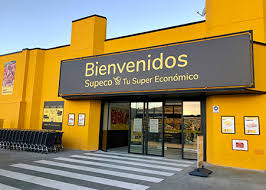 I've discovered some great wristwatches for sale cheaply in Supeco, the yellow supermarket chain which belongs to Carrefour. I've discovered some great wristwatches for sale cheaply in Supeco, the yellow supermarket chain which belongs to Carrefour.
They're such good value that I've bought several in different colours and am basing my new-found "sartorial look" around these watches.
[Photo: Supeco]
They cost a mere 7,90 euros.
What's the reaction?
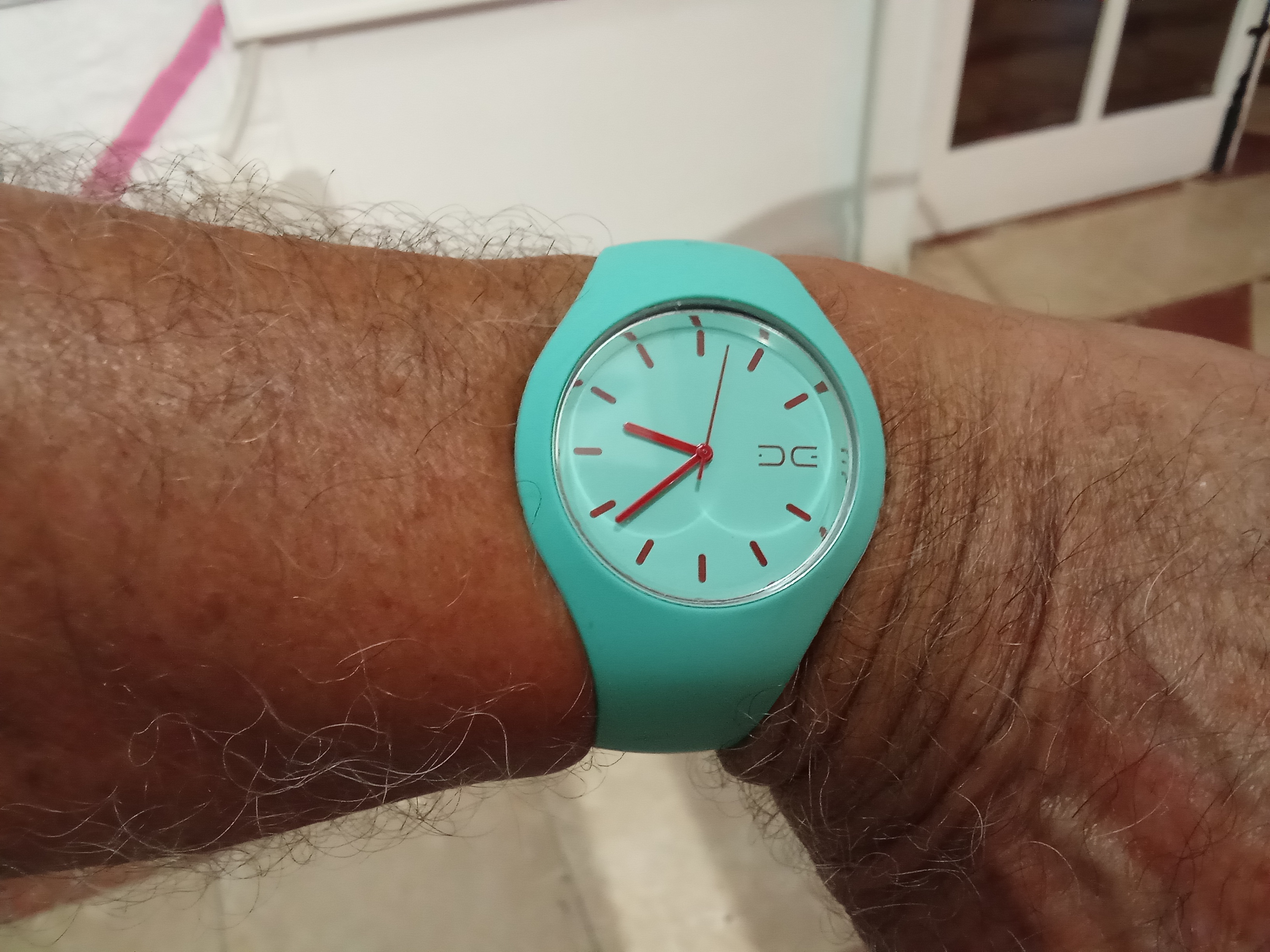 My "lovely Rita" thinks I'm nuts, but that's normal. So I've got a turquoise watch; a darker green one; a pale pink one and a darker pink also; and a white one. My "lovely Rita" thinks I'm nuts, but that's normal. So I've got a turquoise watch; a darker green one; a pale pink one and a darker pink also; and a white one.
What I think has tipped Rita "over the top" is me painting my toenails to match!
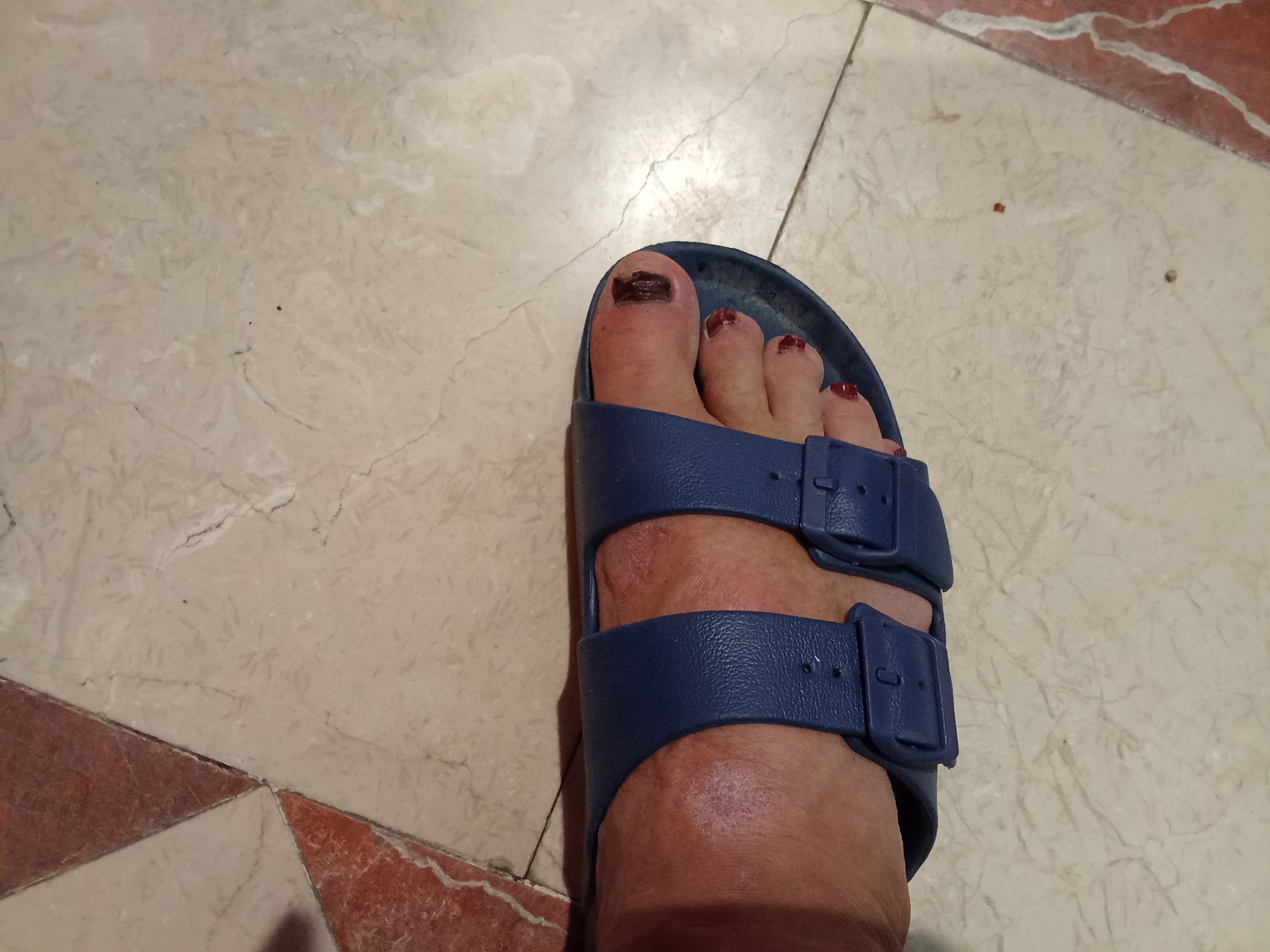
But that makes sense. I have toenail fungus which turns my nails black and is ugly. They are too far gone to be curable, so I go to a podologo (chiropodist) every couple of months and he cuts the nails back and grinds the ridges off.
By the way, I know a couple of other men - without fungus - who paint their toenails. Spaniards. They're not "gay", maybe metrosexuals, but they like it. So do I.
I'm "The Crazy Guy", after all.
Links:
From North Devon to South Spain in seven decades... Part Three: A New Life in Andalucía - Secret Serrania
Golden Wedding anniversary - Eye on Spain
© The Crazy Guy
Photos:
Paul Whitelock, Supeco
Tags:
Carrefour, chiropodist, gay, "Lovely Rita", metrosexual, Paul Whitelock, podologo, Supeco, The Crazy Guy, toenail fungus, watch, wristwatches, yellow supermarket
 0
Like
Published at 9:46 PM Comments (0)
0
Like
Published at 9:46 PM Comments (0)
Two!
Wednesday, August 27, 2025
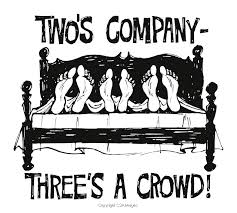 In English, we say "Two's company, three's a crowd". In Spanish "Dos son compañía, tres son multitud". In English, we say "Two's company, three's a crowd". In Spanish "Dos son compañía, tres son multitud".
Yet three is also a common number. As in "the best things come in threes".
[CSA Images]
I prefer "TWO"!
"TWO" is usually good! But not always.
"TWO" in my life
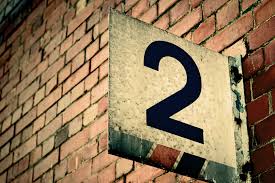 I've had two marriages; I have two houses in Spain; My wife and I have two cars; We have two cats; I have two pensions; so does she; I have two children; each of which has two children. I've had two marriages; I have two houses in Spain; My wife and I have two cars; We have two cats; I have two pensions; so does she; I have two children; each of which has two children.
[Image: Cambridge Dictionary blog]
Let's take a closer look
Marriage
I was married for the first time for 30 years; the second time around we've clocked up 15 already.
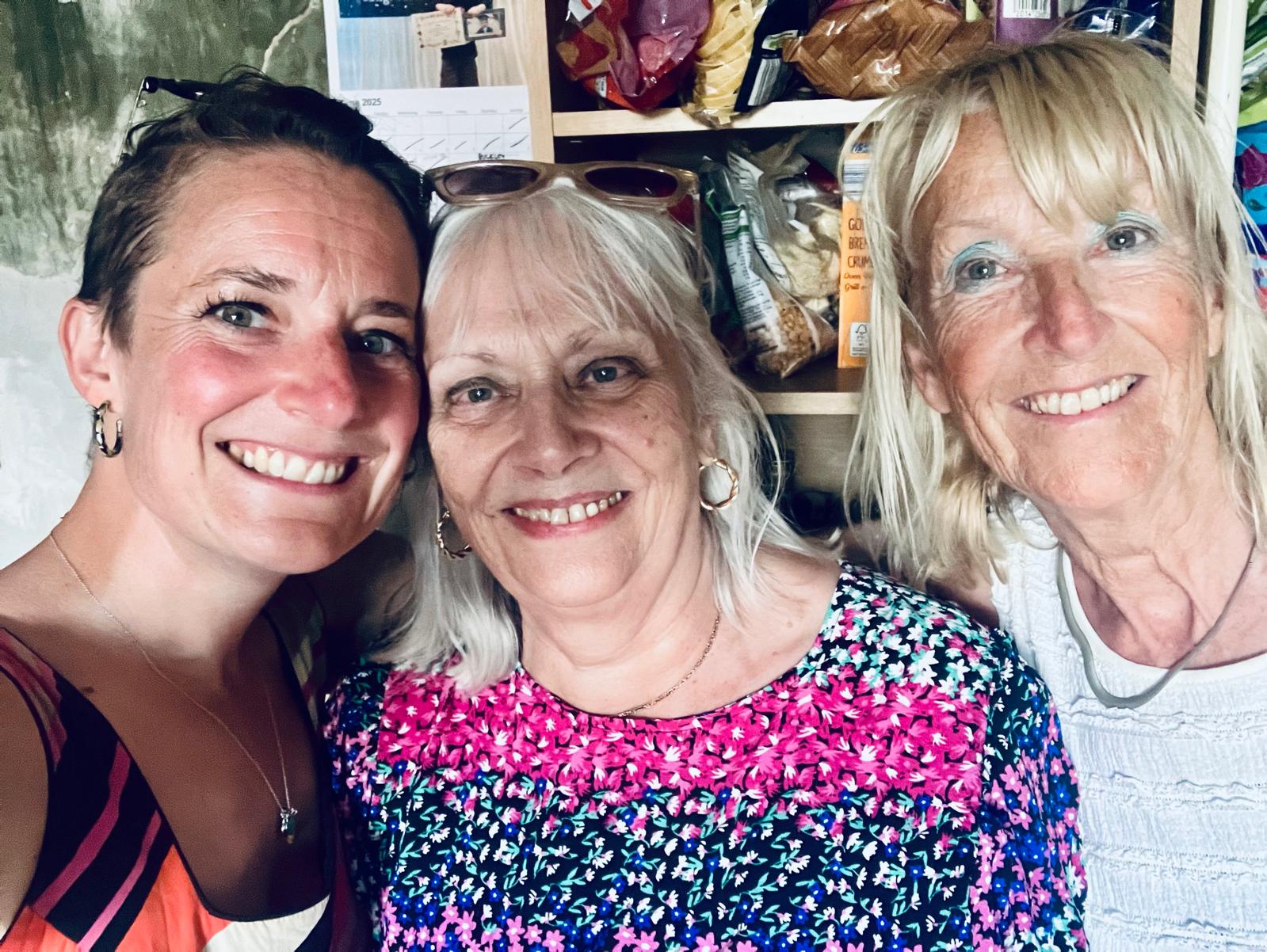 
Daughter Amy, Diane and ex-wife Jeryl [PW] Rita and Paul's wedding [HMR]
Two houses
I own our domicilio and another house in a pueblo blanco which is a holiday rental. Both positive experiences, although now I'm trying to sell the vivienda rural, to realise some cash for our twilight years.
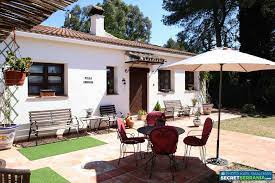 
Villa Indiana [Paul Whitelock] Casa Real [airBnb]
Two cars
We have two cars. Why? I think we could manage with one, but Rita thinks otherwise.
 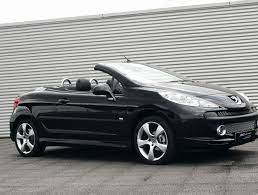
Peugeot 2008 [carwow] Peugeot 207 cabriolet [unattributed]
Two cats
Both are rescue cats which chose us. Pauline and Fritzi are delightful, but they do restrict us.
Two pensions
 I have my UK state pension, which is a pittance. Fortunately I have an occupational pension as well, which is reasonable in Spain. I would be on benefits in the UK. I have my UK state pension, which is a pittance. Fortunately I have an occupational pension as well, which is reasonable in Spain. I would be on benefits in the UK.
Rita also has two pensions, but they are small (she was a stay-at-home mum for years).
[IMAGE courtesy of BBVA]
Two children
I had two children with my first wife, Jeryl, a girl and a boy. They have been an absolute joy.
Grandchildren
 Amy had two boys, Felix and Jude. Tom had two boys also, Wilbur and Buckley. Amy had two boys, Felix and Jude. Tom had two boys also, Wilbur and Buckley.
As a grandparent I enjoy spending time with them, although I'm glad to hand them back at the end of the day.
My English Family [Tom Whitelock]
Conclusion
TWO is a good number in most respects. I would give up on the two cars, but apart from that I don't have a problem with the number.
© The Crazy Guy
Images:
AirBnb, Cambridge Dictionary blog, carwow, CSA Images, HMR, Paul Whitelock, Tom Whitelock,
Tags:
AirBnb, Amy, Buckley, Cambridge Dictionary blog, carwow, CSA Images, domicilio, "Dos son compañía, tres son multitud", Felix, Fritzi, Grandchildren, HMR, holiday rental, Jude, occupational pension, Pauline, Paul Whitelock, pueblo blanco, Rita, rescue cats, "the best things come in threes", The Crazy Guy, Tom, Tom Whitelock, "Two's company, three's a crowd", "Two!", UK state pension, vivienda rural, Wilbur,
 0
Like
Published at 10:33 PM Comments (0)
0
Like
Published at 10:33 PM Comments (0)
Being eco-friendly
Friday, November 22, 2024
 We do our best as a couple to be eco-friendly. We’ve taken a few steps in recent years “to do our bit”, but sometimes trying to be green is damned difficult, expensive and soul-destroying. We do our best as a couple to be eco-friendly. We’ve taken a few steps in recent years “to do our bit”, but sometimes trying to be green is damned difficult, expensive and soul-destroying.
So, what have we done?
Environmentally-friendly equipment
A few years ago, we were hoodwinked by a rogue salesman into buying around 10 grand’s worth of equipment to clean up our unhealthy well water, to desalinate it, to add ozone (O3) to our domestic water, an osmosis device beneath the kitchen sink to give us clean drinking water and a de vice to disinfect our pool water so that we could use less chlorine. Oh, and a super-dooper wet or dry industrial vacuum cleaner, which is de puta madre but too heavy for my frail good lady to use. vice to disinfect our pool water so that we could use less chlorine. Oh, and a super-dooper wet or dry industrial vacuum cleaner, which is de puta madre but too heavy for my frail good lady to use.
Well, the salesman disappeared and the local company that was supposed to provide a maintenance service for all this equipment gave up the contract. As the suppliers were based in Elche near Alicante, five hours away by road, it did not really work, except at huge cost to us. We were very dissatisfied.
Then the osmosis equipment finally gave up the ghost (again!)
Two weeks ago, I chatted to an Irish neighbour who knows his stuff, and who also has such a device.
I called in at the only place I know in and around Ronda, Miguel Cabello, that sells osmosis equipment and they quoted me 1000€ !
I went online to do some research and I’m glad I did. Leroy Merlin, the French-owned DIY store had a range, both in-store and on their website, so off we trolled to Marbella and the La Cañada shopping centre where there is a branch.
Long story short we bought a state-of-the-art osmosis device, made by Philips, surely a reliable brand, and got it for the website price, 50€ cheaper!
Over two days I removed the defective "piece of s**t" supplied by the Elche company [I'm going to name and shame them - Aqualei] and fitted the new device. It works a treat.
Cutting down on meat
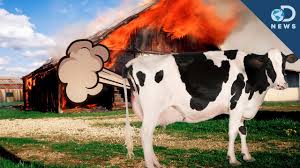 On Rita’s side of the family there are a few vegetarians and vegans. We are neither, but we certainly eat less meat and fish these days, than we used to. On Rita’s side of the family there are a few vegetarians and vegans. We are neither, but we certainly eat less meat and fish these days, than we used to.
Cows farting damage the ozone layer above the earth in a big way.
Growing our own
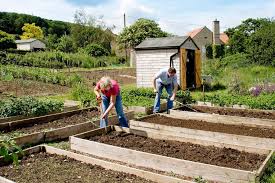 I have always been a keen gardener, a habit inherited from my dear old dad, I reckon. When he had no garden he had a large allotment. Then he eventually got a house with a huge vegetable garden. I have always been a keen gardener, a habit inherited from my dear old dad, I reckon. When he had no garden he had a large allotment. Then he eventually got a house with a huge vegetable garden.
Interestingly, my son Tom, has also inherited the same “tic” and has acquired an allotment near to where he lives with his wife Su and two sons in Hastings (UK).
As for me I have created several raised beds in our garden in Ronda, where I successfully grow artichokes, courgettes, lettuce, green beans, potatoes, spinach and a variety of fruits.
Plastic packaging
Our biggest category of trash is plastic packaging. And you can’t recycle it at our local punto verde.
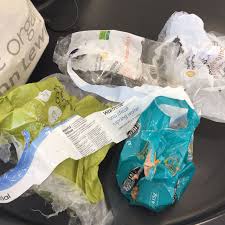 In Germany, where we often go (Rita is German and has a large extended family), it’s normal to unpack what you’ve just bought, eg apples in a plastic pack, and leave the packaging at the check-out. I wonder how the till staff at Mercadona would react if we started doing that in Ronda ..... In Germany, where we often go (Rita is German and has a large extended family), it’s normal to unpack what you’ve just bought, eg apples in a plastic pack, and leave the packaging at the check-out. I wonder how the till staff at Mercadona would react if we started doing that in Ronda .....
I found this article on Country Living magazine's website:
Can You Leave Plastic At The Till In Supermarkets? This Is What Could Happen If You Do – How To Use Less Plastic
In Heilbronn (Baden-Wuerttemberg) there is a shop where everything you buy is loose. You have to take your own bags.
Many countries now levy a charge on plastic bags at the shops. That has worked well and shoppers now routinely re-use bags they already have and take them with them when they go shopping.
Also, in Germany and other mainland European countries, all manner of containers, from glass to plastic to Tetra Paks, are recycled against Pfand (a deposit). In Spain all these things go into normal trash.
Eco-houses
I’ve already mentioned what we did in our domicilio.
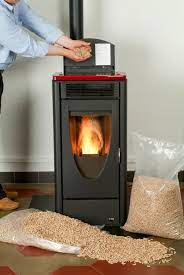 But we have two other houses. Rita’s Casa Rita, where she was living when I met her 16 years ago, is very eco-friendly. During the Covid lockdowns we had all the windows and doors replaced with double-glazed units, and we installed a pellet stove. We bought state-of-the-art gas fires to add to the eco/friendliness of the house. But we have two other houses. Rita’s Casa Rita, where she was living when I met her 16 years ago, is very eco-friendly. During the Covid lockdowns we had all the windows and doors replaced with double-glazed units, and we installed a pellet stove. We bought state-of-the-art gas fires to add to the eco/friendliness of the house.
My do-er up-per, Casa Real, was designed to be an eco-house from the outset. double- glazed units installed, and a pellet stove.
The electrodomésticos (white goods) were all brand new and therefore by definition eco-friendly.
Many of the furnishings and fittings were “rescued” from rubbish dumps or bought from second-hand shops and up-cycled by me.
Firewood for free
We have oil-fired central heating at home, but if it’s really cold we prefer to light the chimenea. We’ve always bought leña from local suppliers, but it has become very expensive in recent years, since the Covid-19 pandemic, in fact. I’m not sure why that should have caused the price of firewood to rise so sharply. The term "profiteering" comes to mind .....
 So, over the last few years I’ve been looking at a cheaper alternative, which is also more environmentally friendly. Recycling wood from the basura (rubbish tip) is a good bet. It’s free, and there’s loads of it readily available. So, over the last few years I’ve been looking at a cheaper alternative, which is also more environmentally friendly. Recycling wood from the basura (rubbish tip) is a good bet. It’s free, and there’s loads of it readily available.
Old pallets and other wooden trash sawn up into “bite-size” pieces are perfect. And it stops it all going into landfill.
Okay, this type of wood burns much quicker than a cork oak log or a chunk of olive tree, but, so what, IT’S FREE!
Compost
I have two compost systems. I want to see which works best, aerobic or anaerobic.
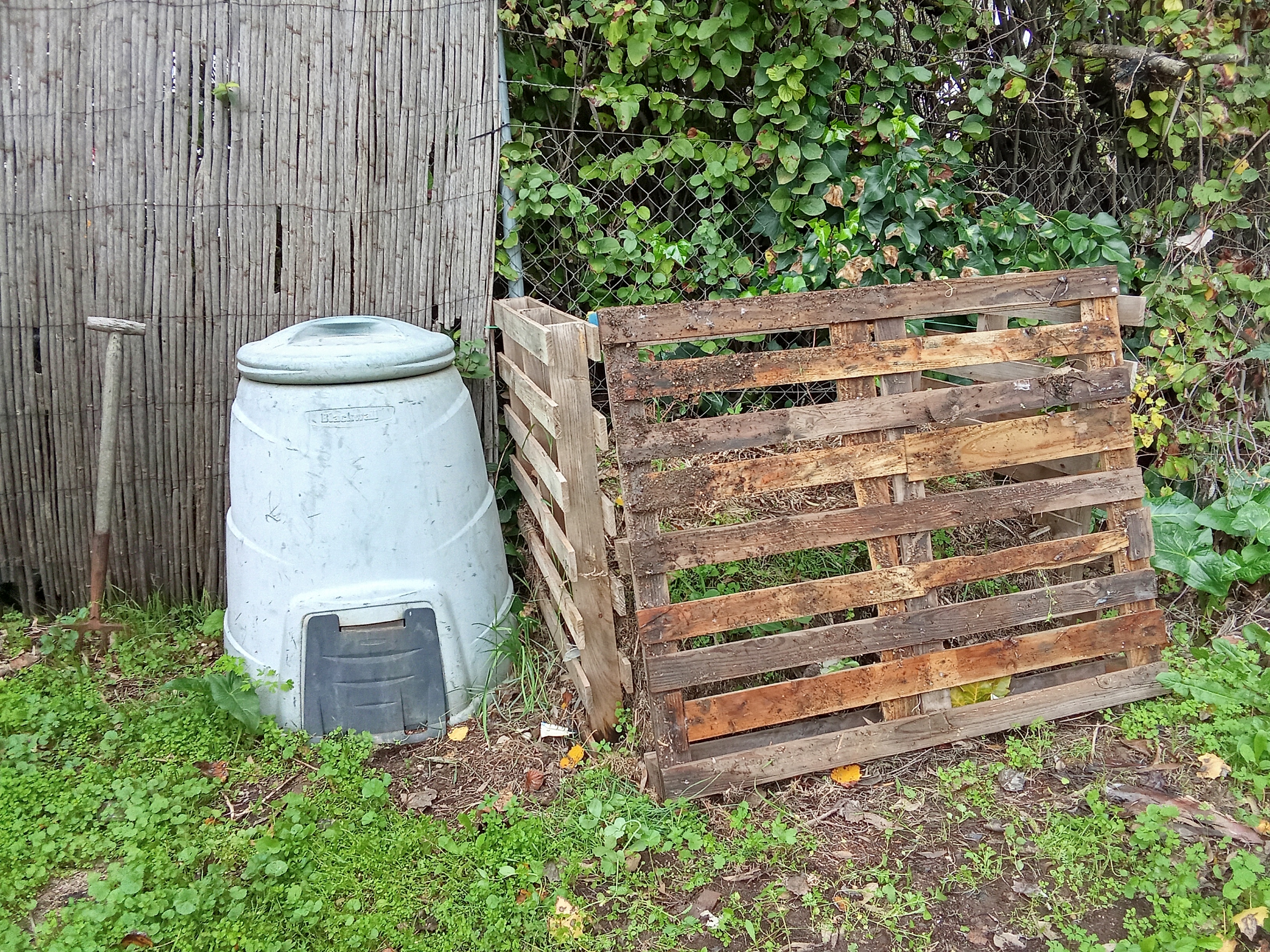 I brought an anaerobic plastic compost bin from England. That always made great compost back there and it’s looking promising here in Andalucia also. I brought an anaerobic plastic compost bin from England. That always made great compost back there and it’s looking promising here in Andalucia also.
The only thing that concerns me here is the lack of worms, who love to dine on the kitchen waste and then “poo” it out as lovely crumbly compost.
I also built a large aerobic heap, using pallets as “walls”. This is less successful, I feel, as it’s hard to keep it moist in the hot, dry weather.
But we shall see …..
© The Crazy Guy
Links:
Can You Leave Plastic At The Till In Supermarkets? This Is What Could Happen If You Do – How To Use Less Plastic
Montejaque Metamorphosis
Acknowledgements (Photos):
Country Living
Depositphotos
Ecologia verde
Facebook
Freepik
Gardener's World (BBC)
La Caixa
Leroy Merlin
YouTube
Tags:
aerobic, anaerobic, Aqualei, Baden-Wuerttemberg, basura, charge on plastic bags, check-out, chimenea, compost system, cork oak, Country Living, Covid-19 pandemic, cows farting, crumbly compost, Depositphotos, Ecologia verde, Elche, Facebook, Freepik, Gardener's World (BBC), German, Germany, glass, Heilbronn, La Caixa, La Cañada, lack of worms, landfill, leave the packaging at the check-out, leña, Leroy Merlin, Marbella, Mercadona, Miguel Cabello, Montejaque Metamorphosis, oil-fired central heating, olive tree, osmosis equipment, ozone layer, pallet, Pfand, Philips, plastic, plastic compost bin, plastic packaging, punto verde, recycling wood, Rita, Ronda,Tetra Paks, The Crazy Guy, wooden trash, YouTube
 0
Like
Published at 10:32 AM Comments (1)
0
Like
Published at 10:32 AM Comments (1)
A Life in the Day of The Crazy Guy
Wednesday, May 1, 2024
 Saturday was not a typical day in the life of The Crazy Guy, but maybe it was ….. It was certainly chaotic! This is what happened …… Saturday was not a typical day in the life of The Crazy Guy, but maybe it was ….. It was certainly chaotic! This is what happened ……
Up at 02.15 am for a pee and again at 06.50 am. What else happened that day?
Before dawn broke
 We had some leftover spuds from dinner the night before, so I made a tortilla de patatas con tomates. ¡Deliciosa! We had some leftover spuds from dinner the night before, so I made a tortilla de patatas con tomates. ¡Deliciosa!
Watched SKY News. Boring, the same old, same old. Since 4 April we have had no other UK channels. They switched off the satellite above the US military base over Rota (Cádiz), which we had been using since the Astra B satellite stopped providing UK TV channels, several years ago.
I tried the Spanish News on La 1 but it was just as boring: Gaza Strip, Ukraine and Rishi Sunak’s pathetic gimmicks to try and win the next general election in the UK at the end of the year.
A new day dawns
Rain was forecast, so I didn’t start what I had planned. Instead, the missus and I cleaned the pool which had a lot of Saharan sand on the bottom, as a result of the recent calima.
Saturday morning
 I’d just picked up a contract for some building work in Ronda, so, having received an upfront payment of 50% of the estimate from the client, I went off to Big Mat La Toma to buy tiles and grout. I’d just picked up a contract for some building work in Ronda, so, having received an upfront payment of 50% of the estimate from the client, I went off to Big Mat La Toma to buy tiles and grout.
Then I got a message from the client, cancelling our contract and asking for her money back!
Too late, mate!
No explanation as to why, although I have my suspicions. Anyway, I deducted the cost of the materials I’d already bought, plus an amount for my time, and returned the balance.
Saturday afternoon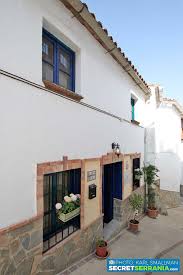
Drove to Montejaque, where I have a house I “reformed”, to sort the place out ready for an upcoming booking.
I contacted “Dusty” about buying a pre-loaded Amazon Firestick so that I can watch UK TV again.
Saturday night
Popped into my local, the Ronda Valley Hotel, for a few pre-prandials with some pals before enjoying a nice Saturday night dinner with the missus.
And so to bed
Tired by this time, I was ready for bed. I couldn’t watch Match of the Day, as I normally would on a Saturday night.
Why not? Er, no UK TV!
© The Crazy Guy
Acknowledgements (Photos):
Big Mat La Toma
Comidas Recetas
Karl Smallman
Secret Serrania
YouTube
Tags:
A Life in the Day, Amazon Firestick, Astra B satellite, Big Mat La Toma, Comidas Recetas, Crazy Guy, “Dusty”, Gaza Strip, general election in the UK, Karl Smallman, La 1, Match of the Day, Montejaque, Rishi Sunak, Ronda Valley Hotel, Rota (Cádiz), Secret Serrania, Sky News, Spanish News, tortilla de patatas con tomates, Ukraine, UK TV, UK TV channels,YouTube
 0
Like
Published at 9:42 AM Comments (2)
0
Like
Published at 9:42 AM Comments (2)
About Ronda Roundabouts (and murals)
Friday, April 19, 2024
About Ronda Roundabouts (and murals)
By The Crazy Guy
19 April 2024
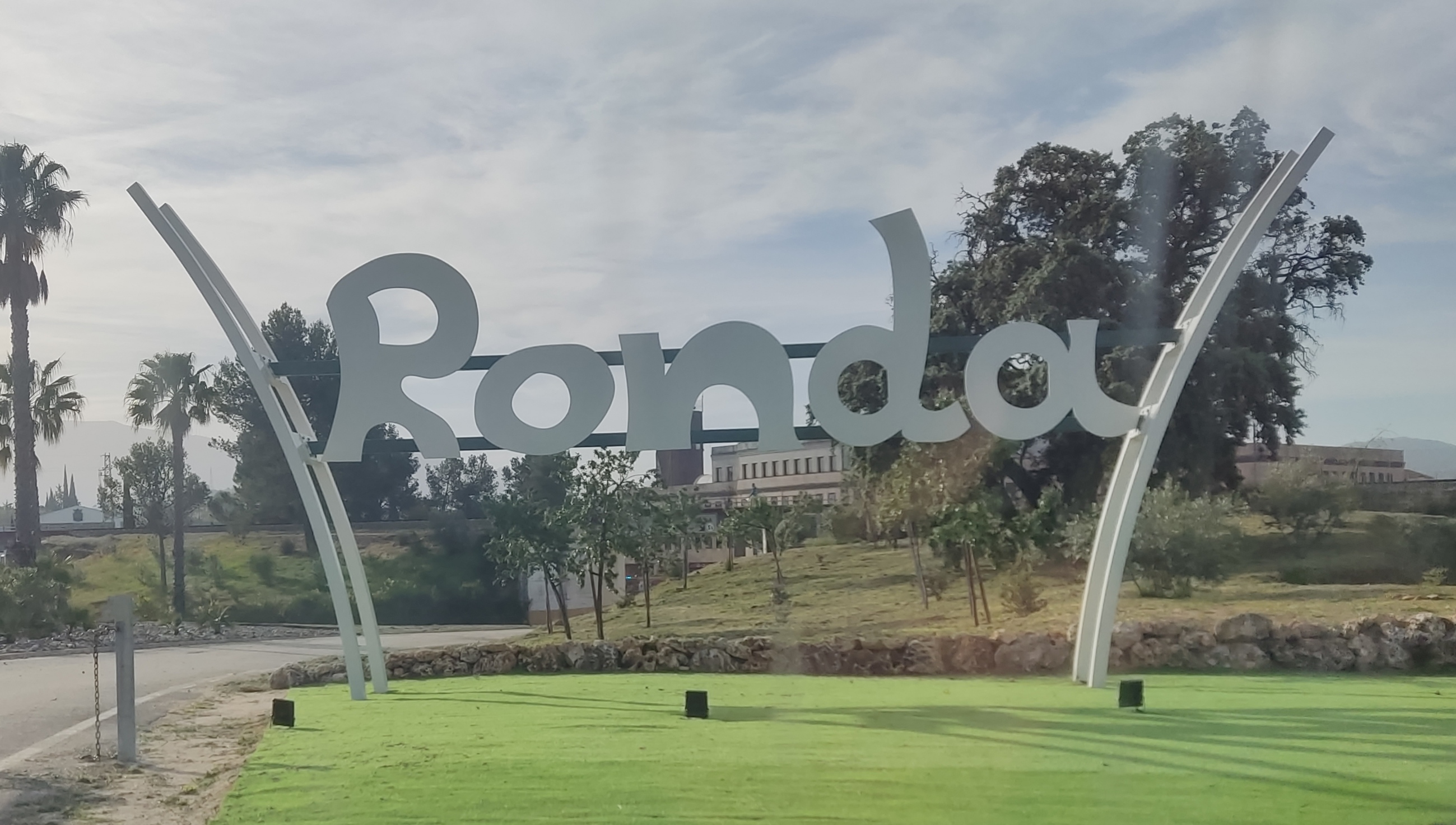 There is a roundabout at nearly every entrance to the town of Ronda (Málaga) – at all points of the compass. Each hosts a symbol or erection of some kind. Within the town itself, they’ve gone in for murals in a big way. The Crazy Guy can think of at least ten. He takes a look. There is a roundabout at nearly every entrance to the town of Ronda (Málaga) – at all points of the compass. Each hosts a symbol or erection of some kind. Within the town itself, they’ve gone in for murals in a big way. The Crazy Guy can think of at least ten. He takes a look.
North by Northwest
Arriving on the A367 Campillos Road you drive past Bar La Fragua, or you stop and call in for coffee or breakfast to see the lovely waitress Nati. Here is also the best car valeting service in town, Lavacar – just 15€, and next door to that is is Viveros Gomez, the garden centre.
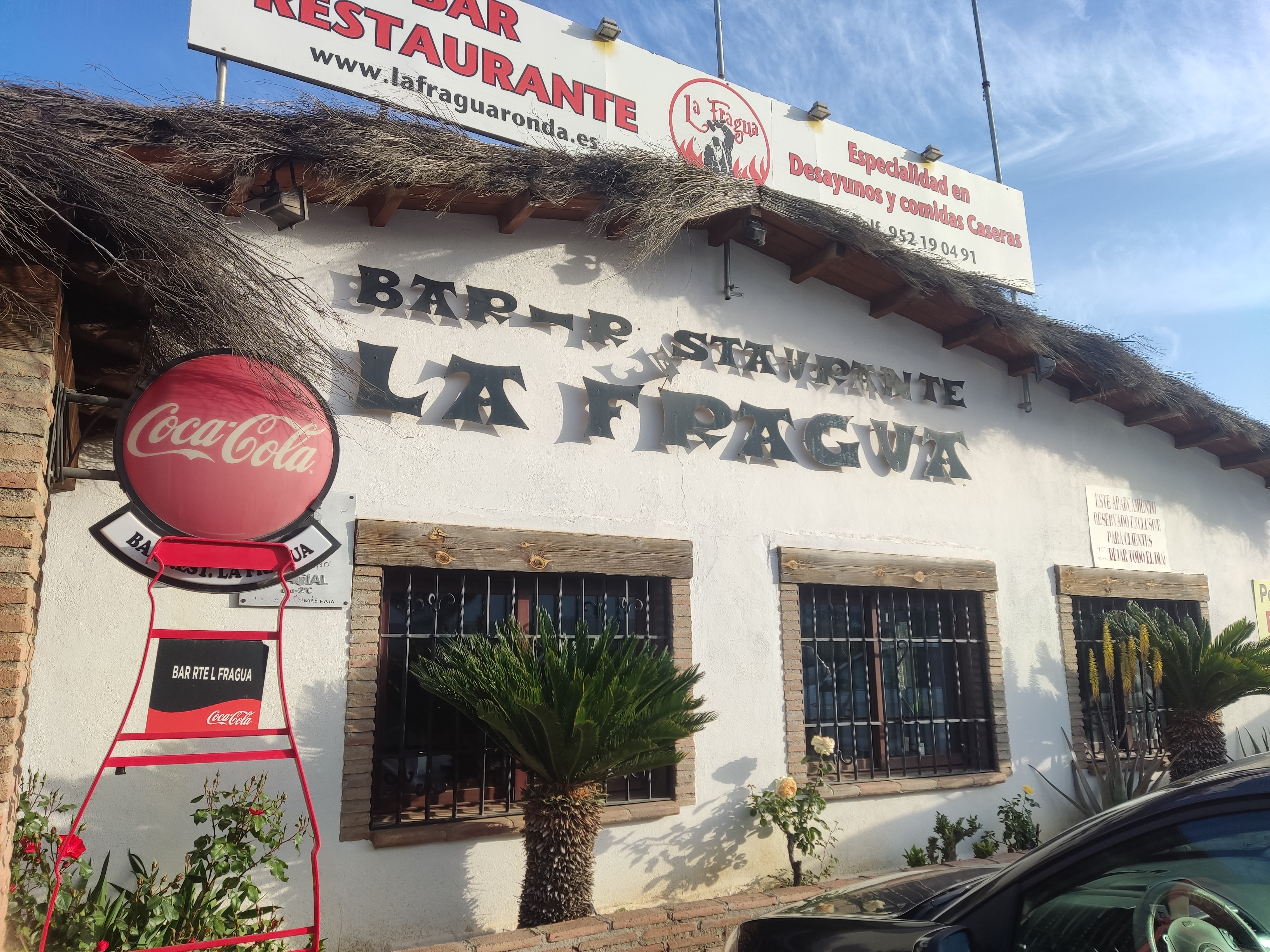 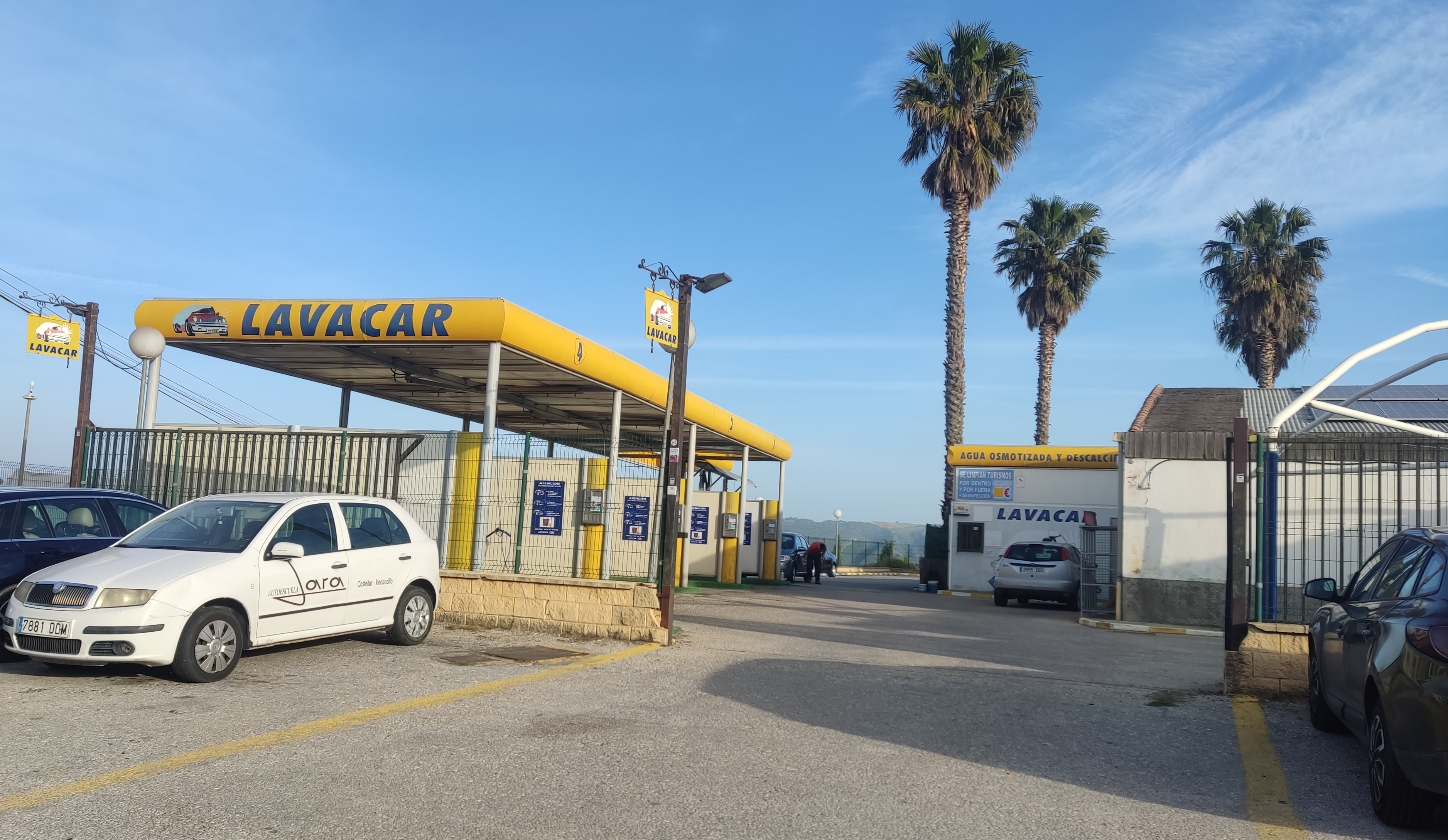 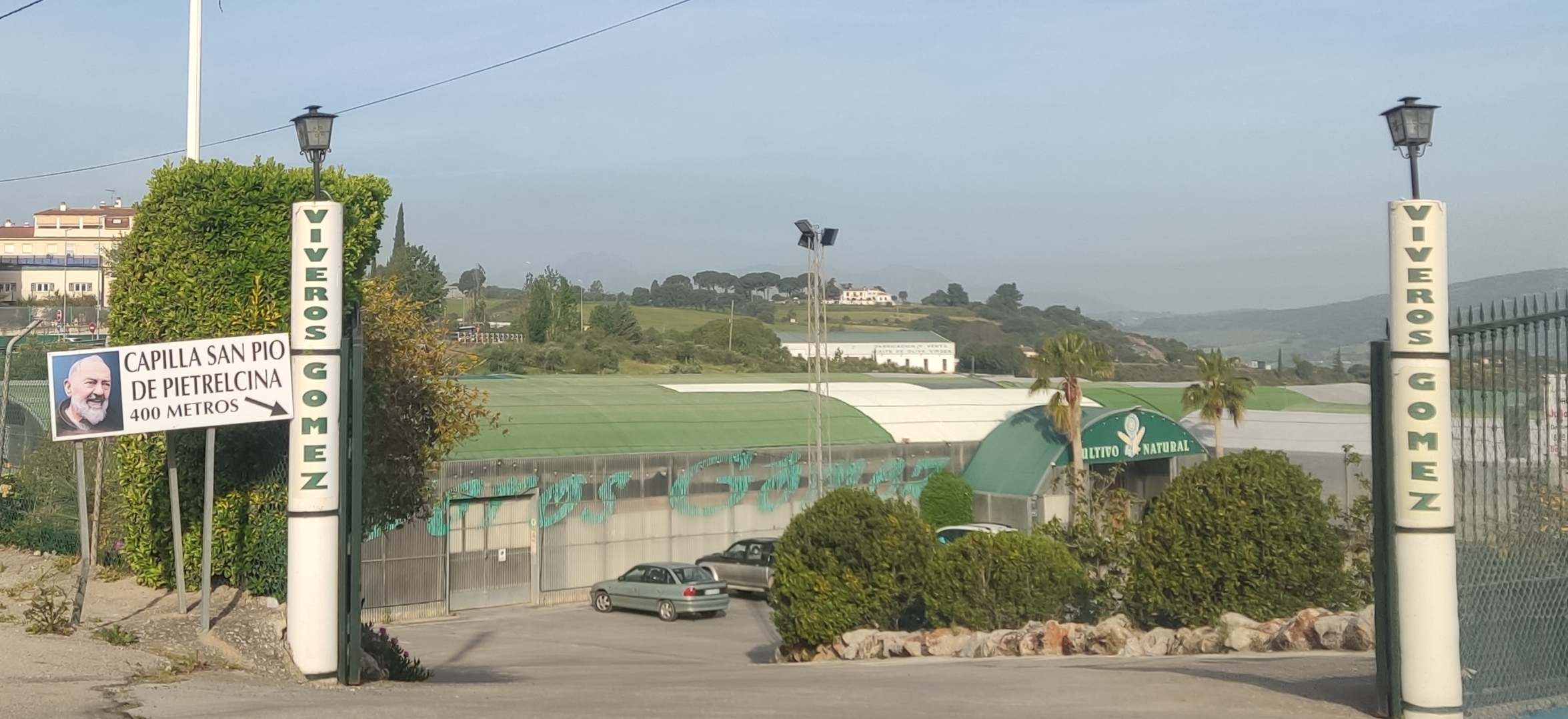
Next is the biggest roundabout of all located beneath the Algeciras to Bobadilla railway line as it heads into Ronda.
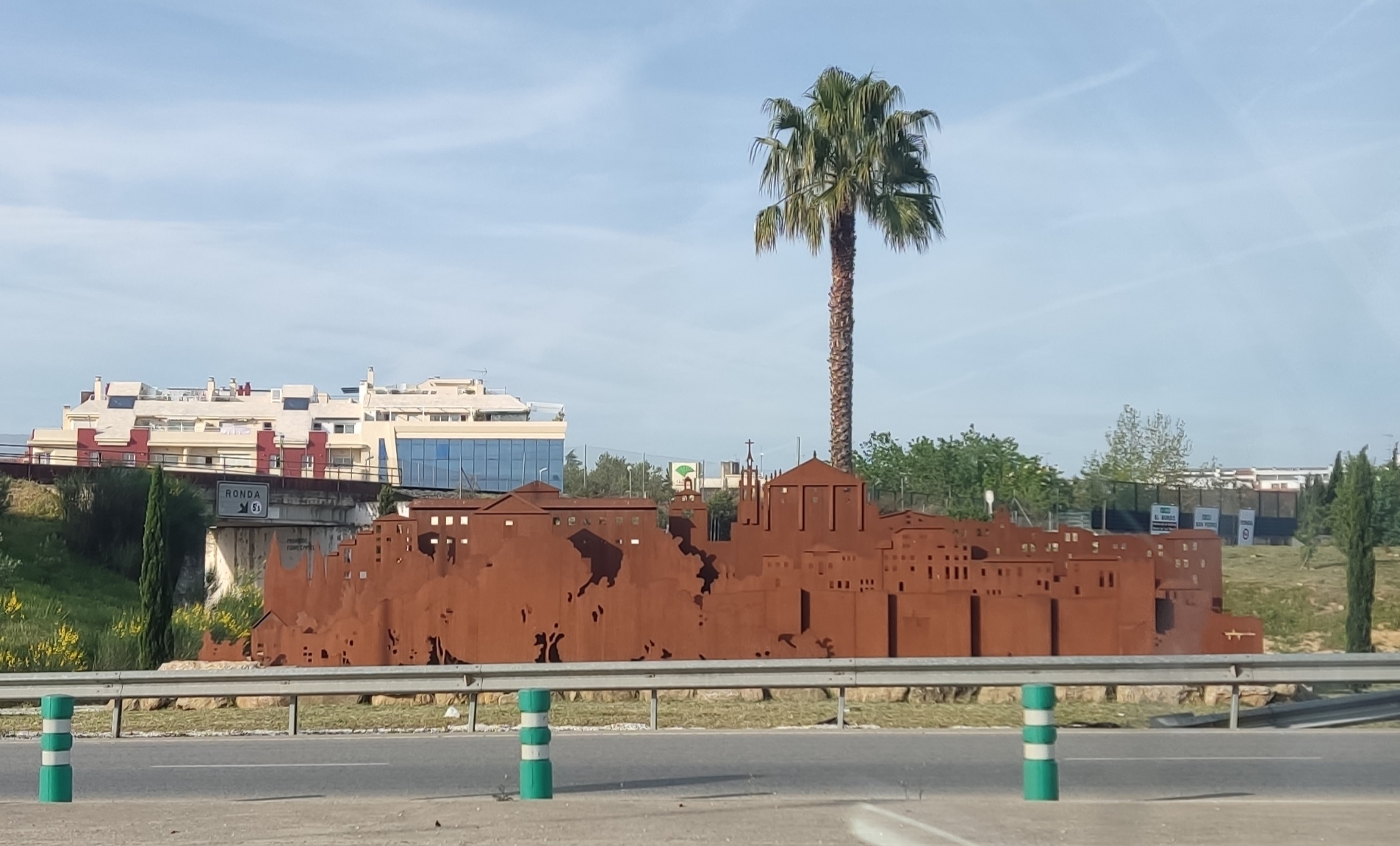 The first thing you see on this roundabout is what looks like a lump of rusty metal. On closer examination you realise it’s a silhouette of a skyline, presumably Ronda. The first thing you see on this roundabout is what looks like a lump of rusty metal. On closer examination you realise it’s a silhouette of a skyline, presumably Ronda.
They go in for rusty stuff around here, by the way, cf. the entrance to the village of El Gastor on the Seville Road.
There is also a big sign welcoming the visitor to Ronda here (see main photo above).
As you h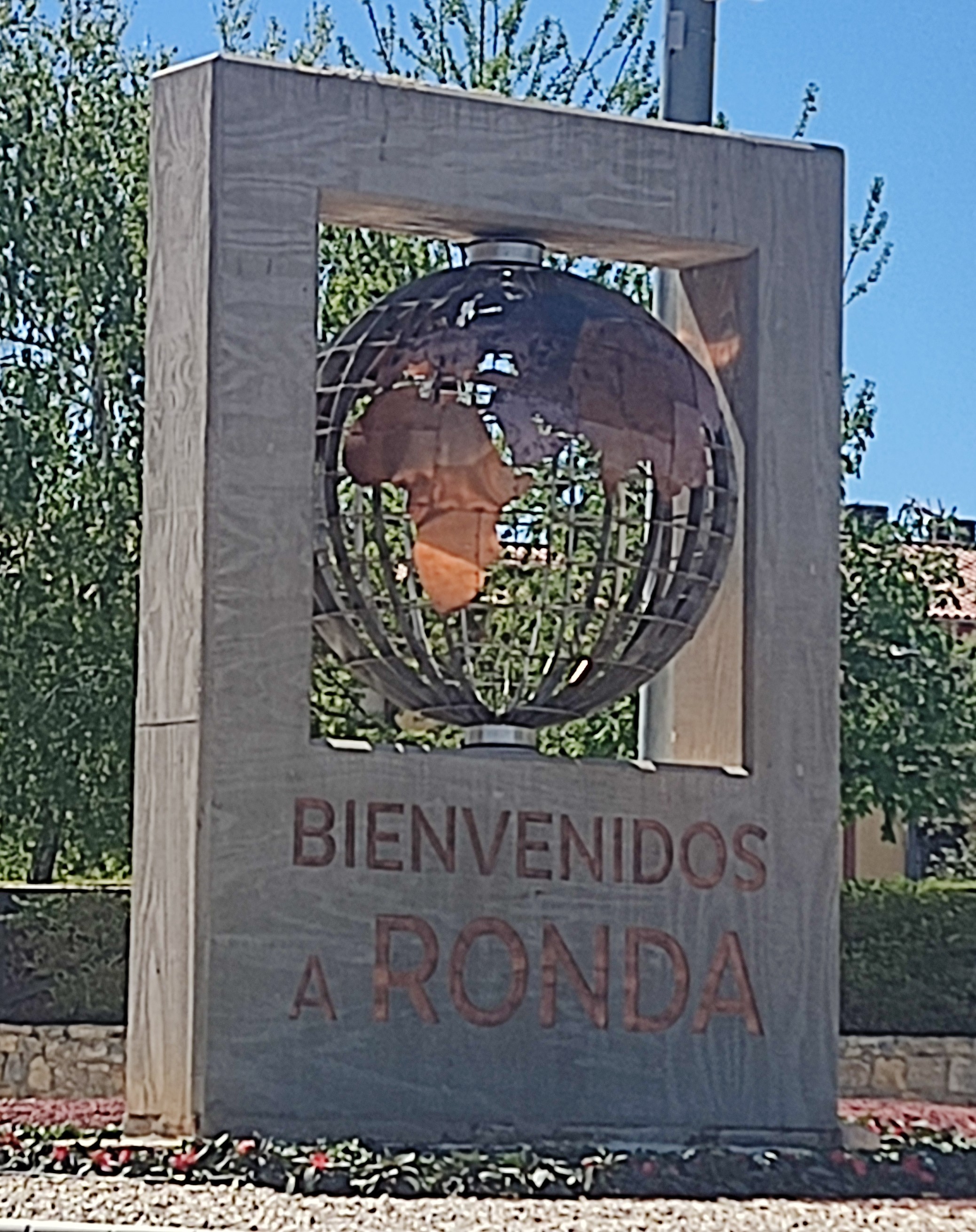 ead onto Avenida de Málaga there is another roundabout, a small one, which hosts a globe of the world and the message Bienvenidos a Ronda. ead onto Avenida de Málaga there is another roundabout, a small one, which hosts a globe of the world and the message Bienvenidos a Ronda.
Avenida de Málaga is a rich source of murals. There are five to the right opposite the CEPSA petrol station (the dearest in town).
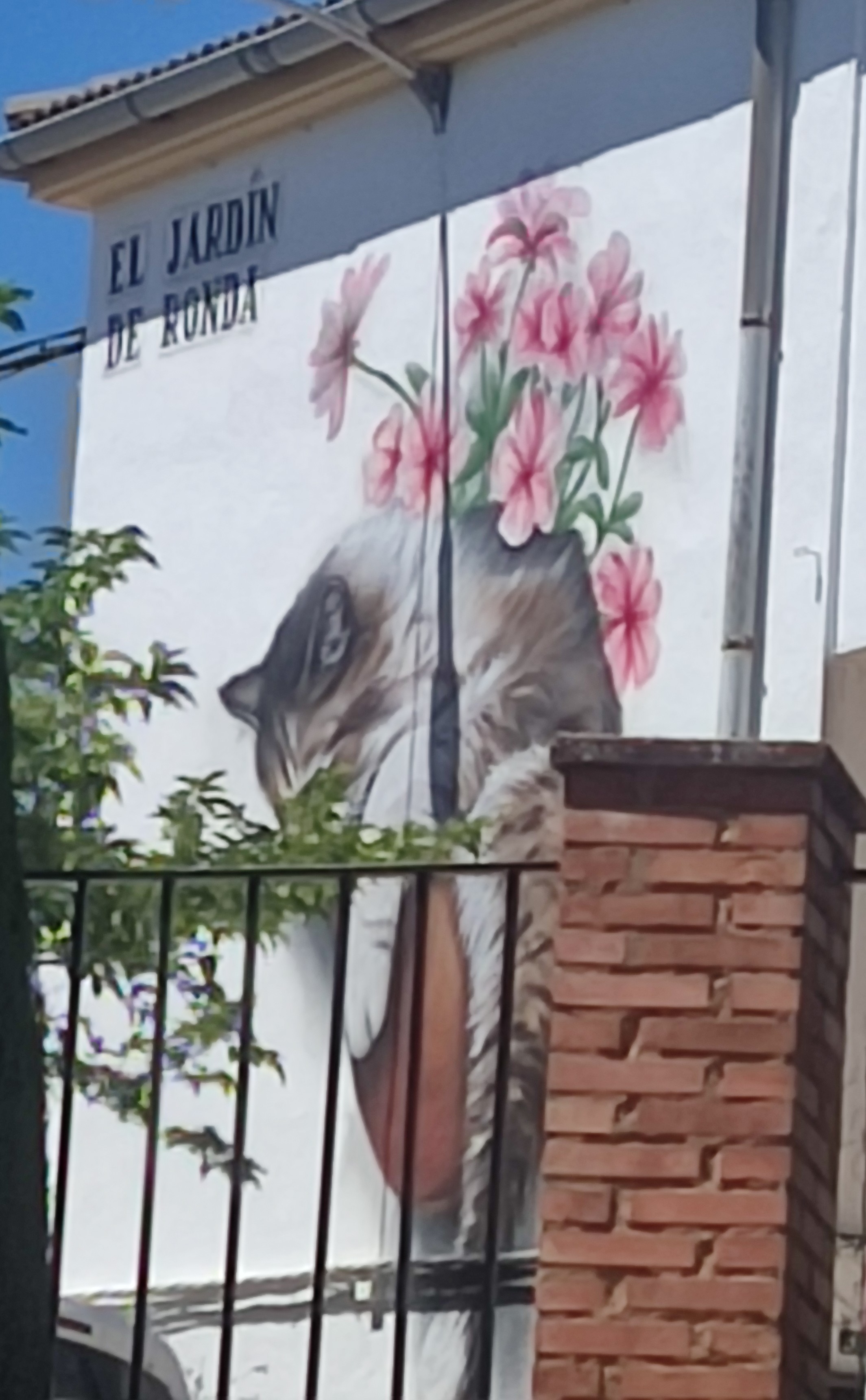 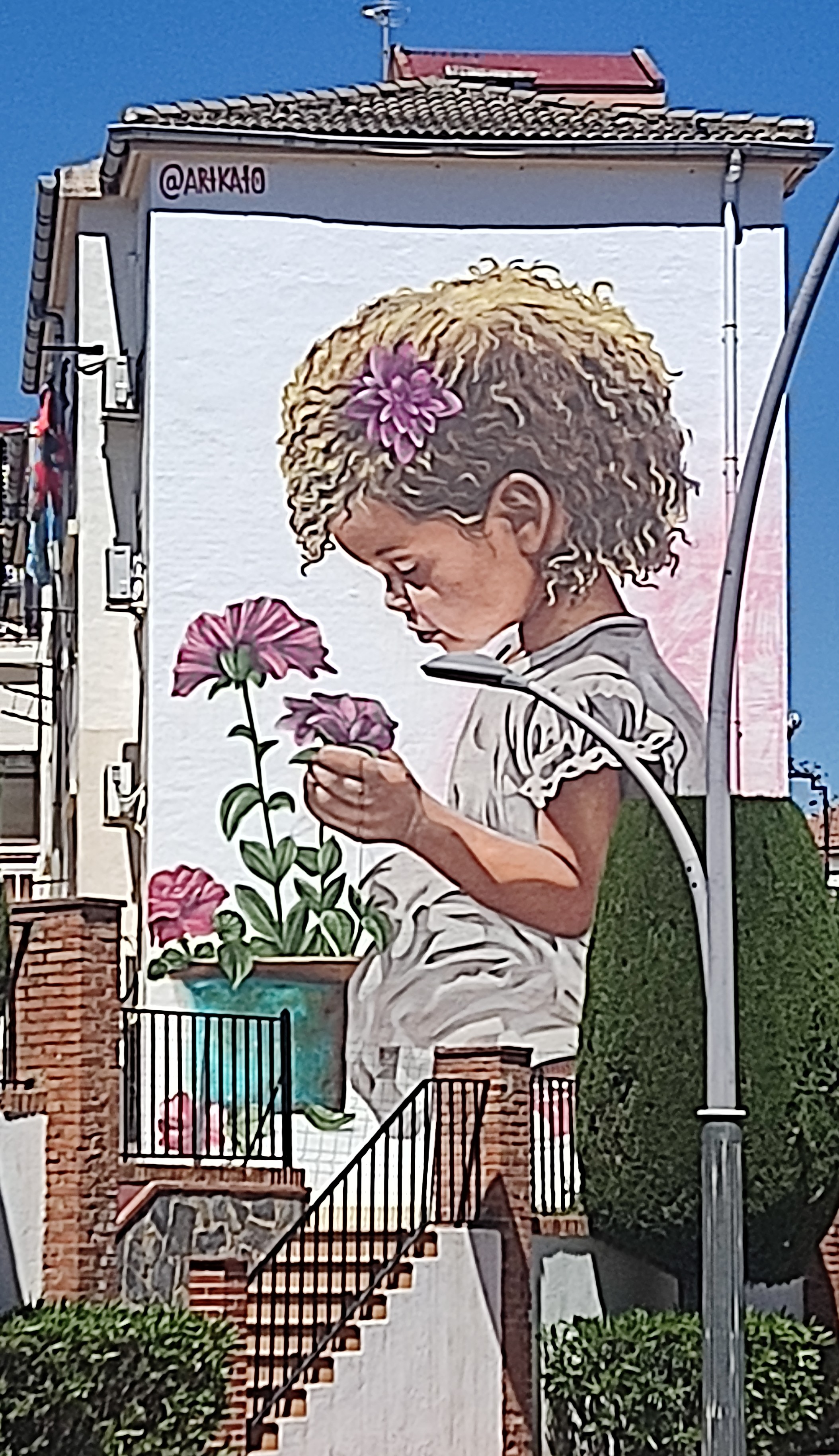 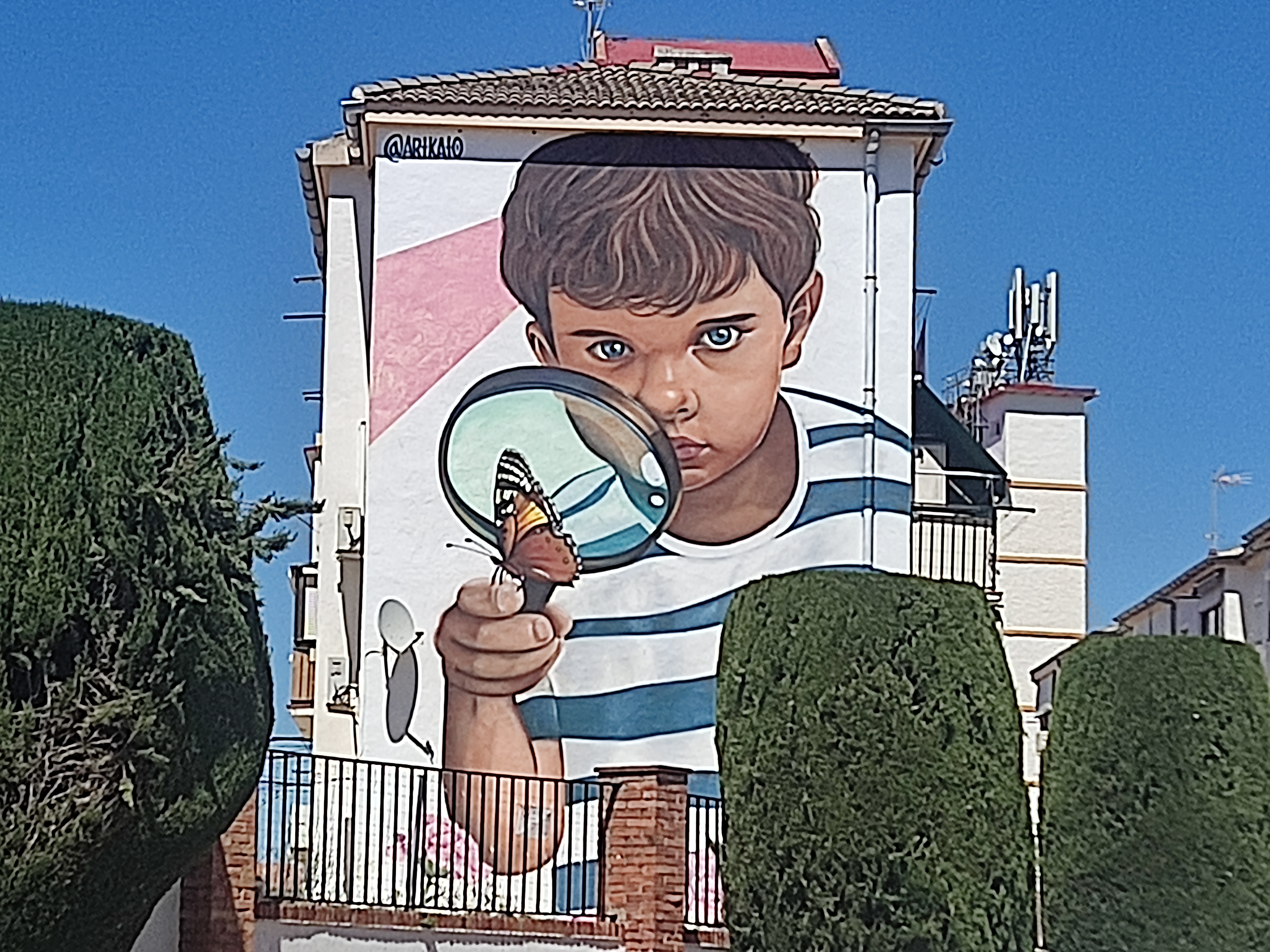
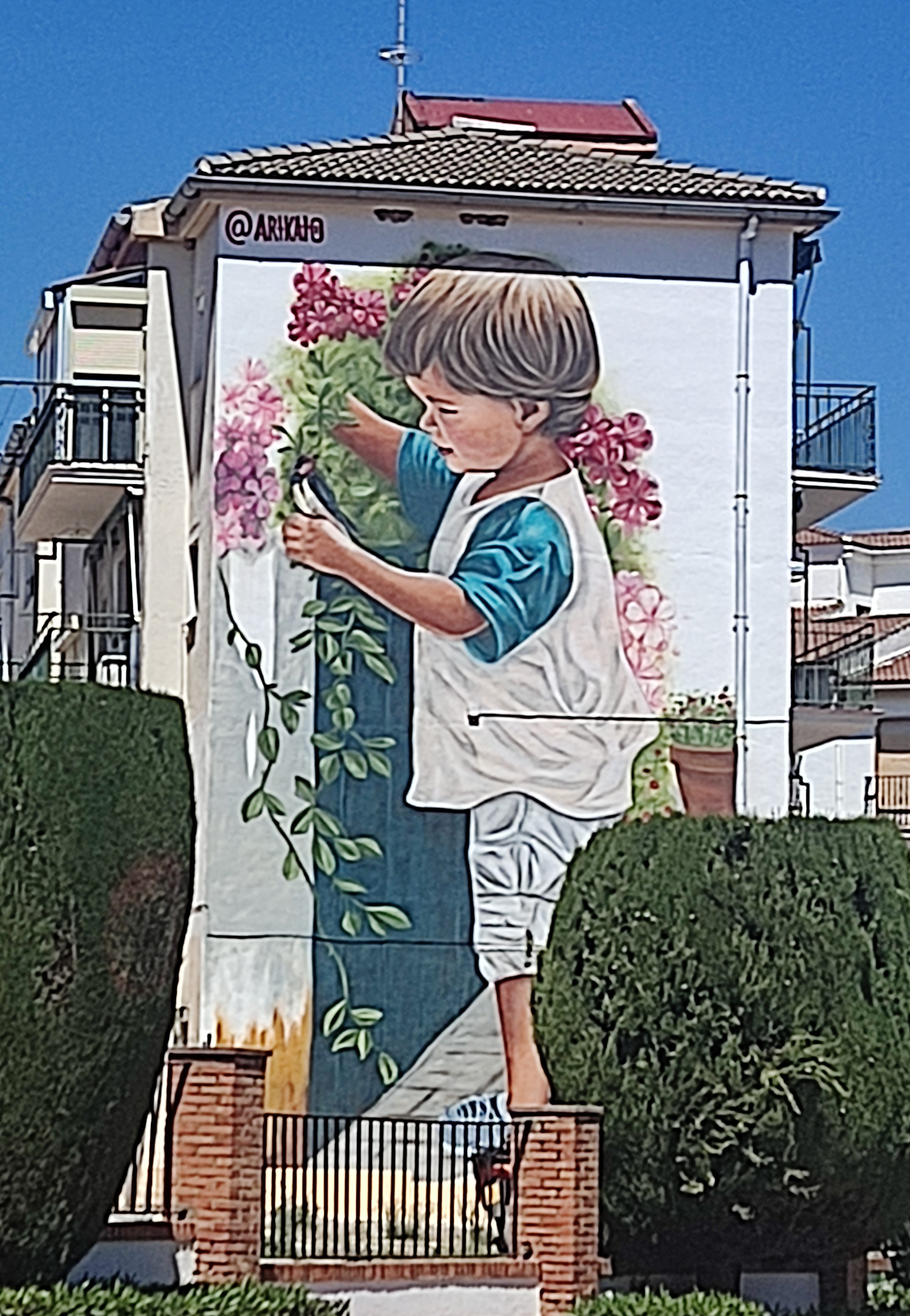 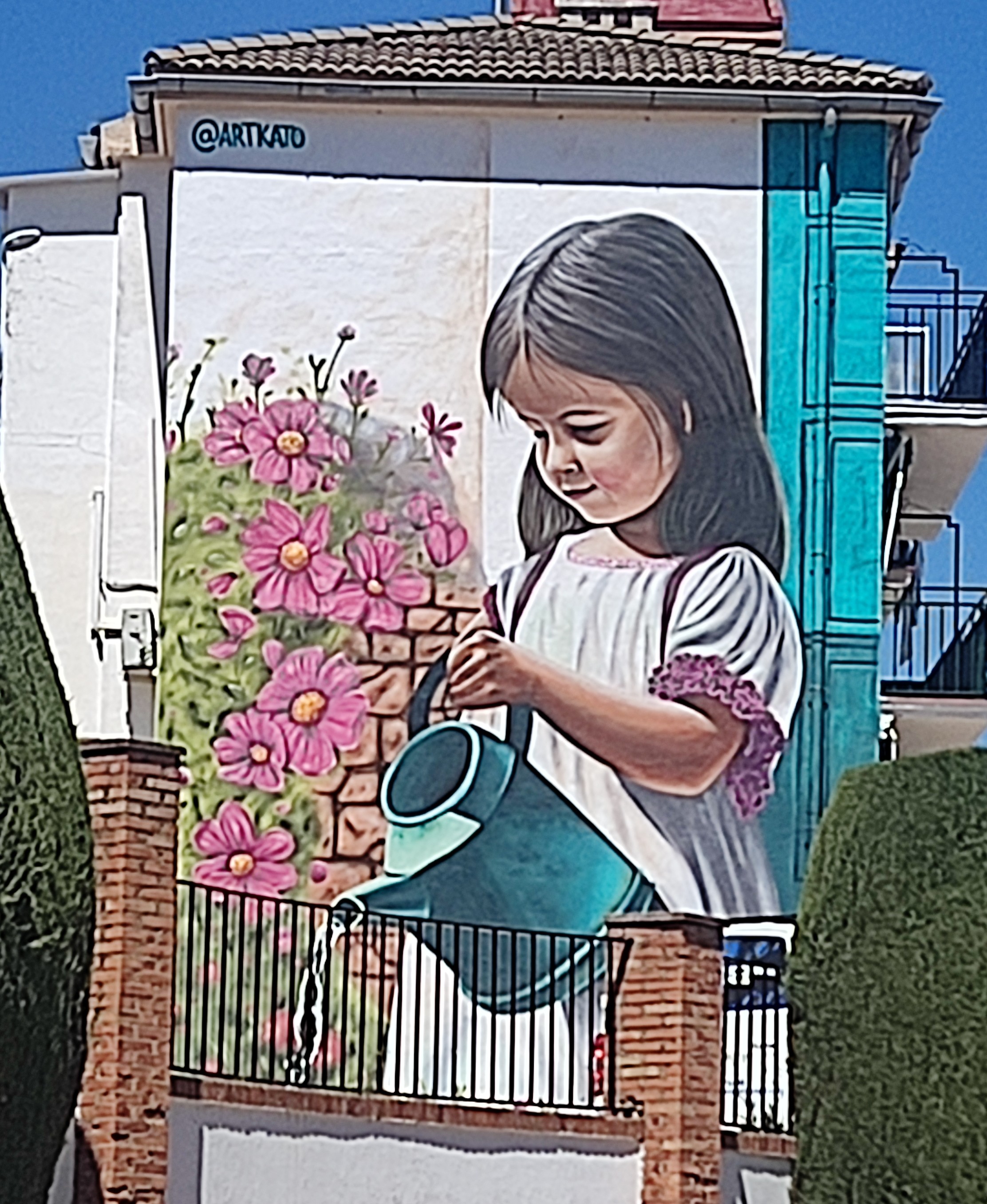
These are located on the “gable ends” of five blocks of flats and are rather charming. They are by the Basque graffiti artist Arikaio, a kind of Spanish “Banksie”, the celebrated British graffiti dauber.
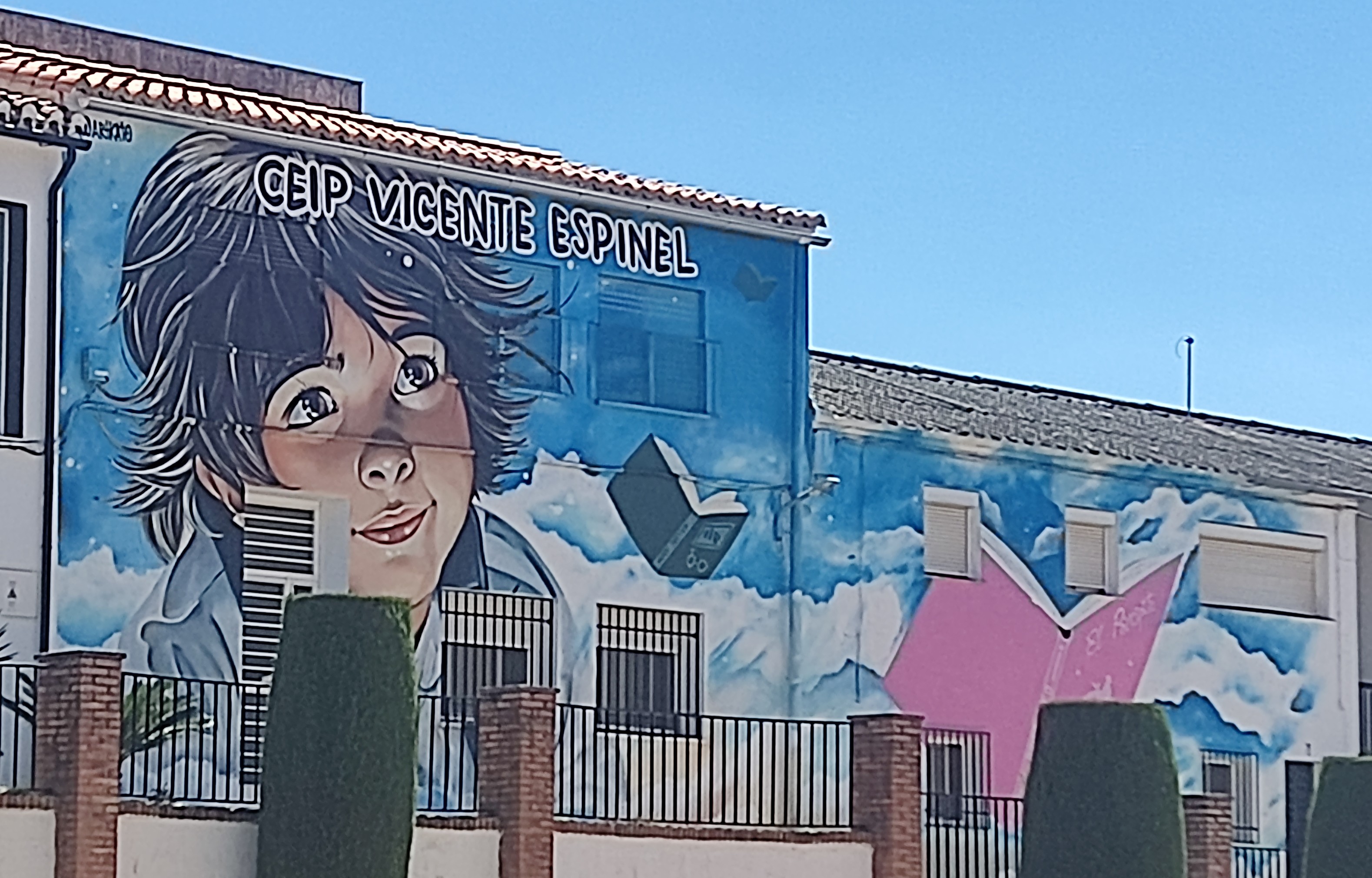
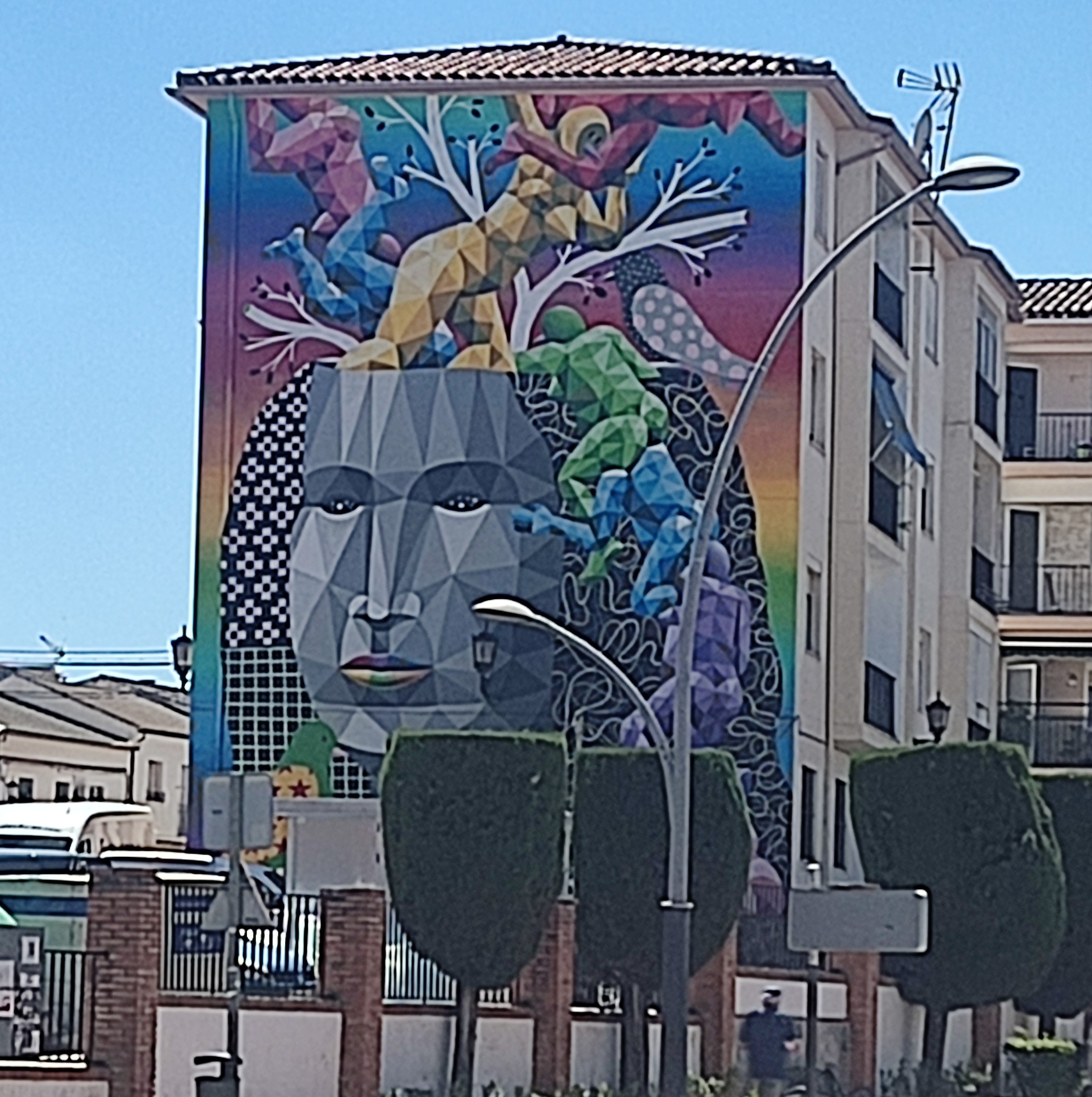
Further on, on the other side of the road, is a splendid rendition on an end wall of a Spanish señorita, the third mural in the town by artist Óscar San Miguel, also known as Okuda.
A bit further on, just past the Guardia Civil Barracks, if you look up to your left there is another mural on a primary school.
Head back to the big roundabout and take the A376 road signposted Sevilla. Almost immediately there is an exit onto the Polígono Industrial, the industrial or trading estate. No roundabout here, so no statue or symbol.
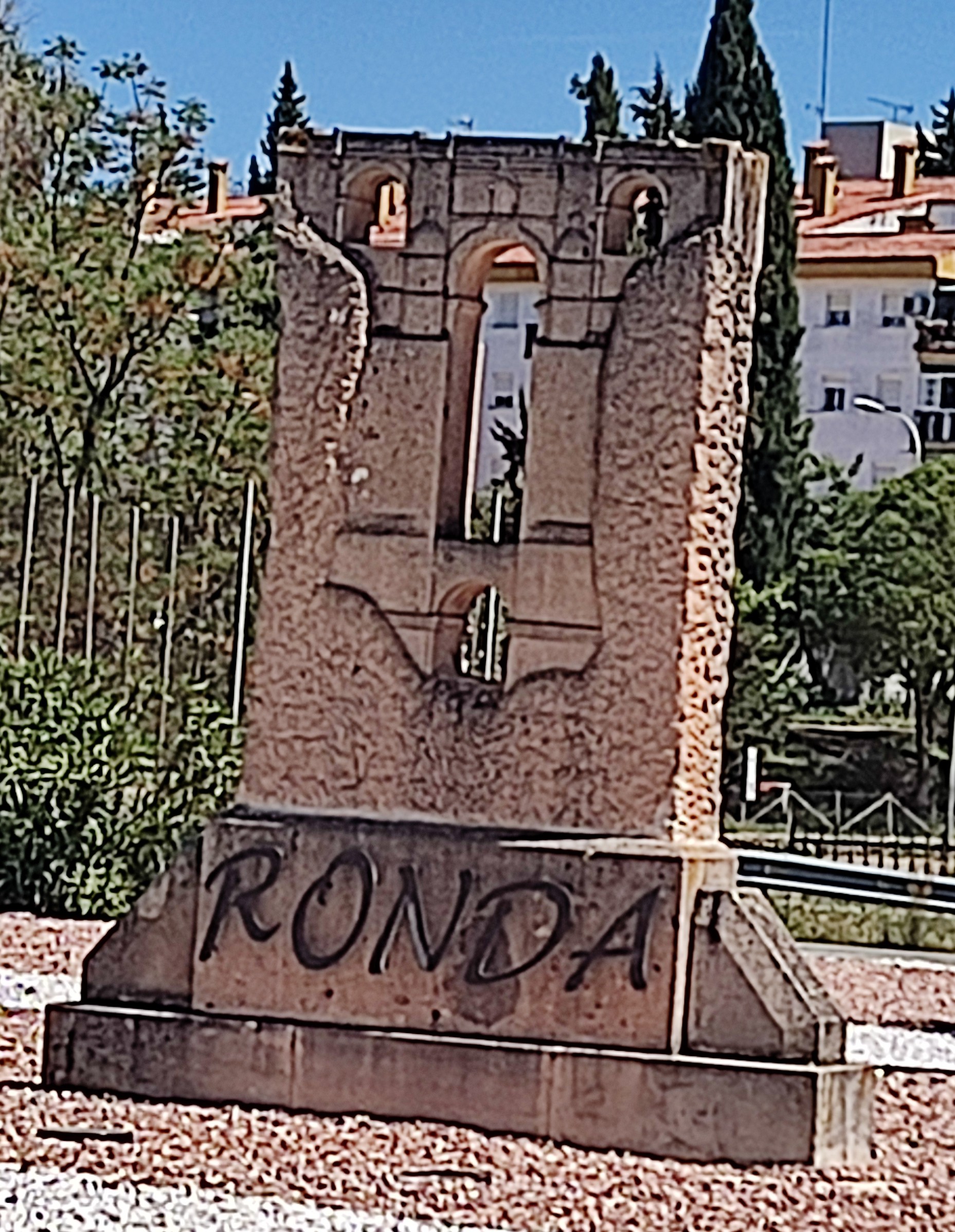 Back onto the main road and the next entrance into the City of the Tajo is the North West entrance. Here is a roundabout with a sculpture of the Puente Nuevo, the emblematic symbol of Ronda. Back onto the main road and the next entrance into the City of the Tajo is the North West entrance. Here is a roundabout with a sculpture of the Puente Nuevo, the emblematic symbol of Ronda.
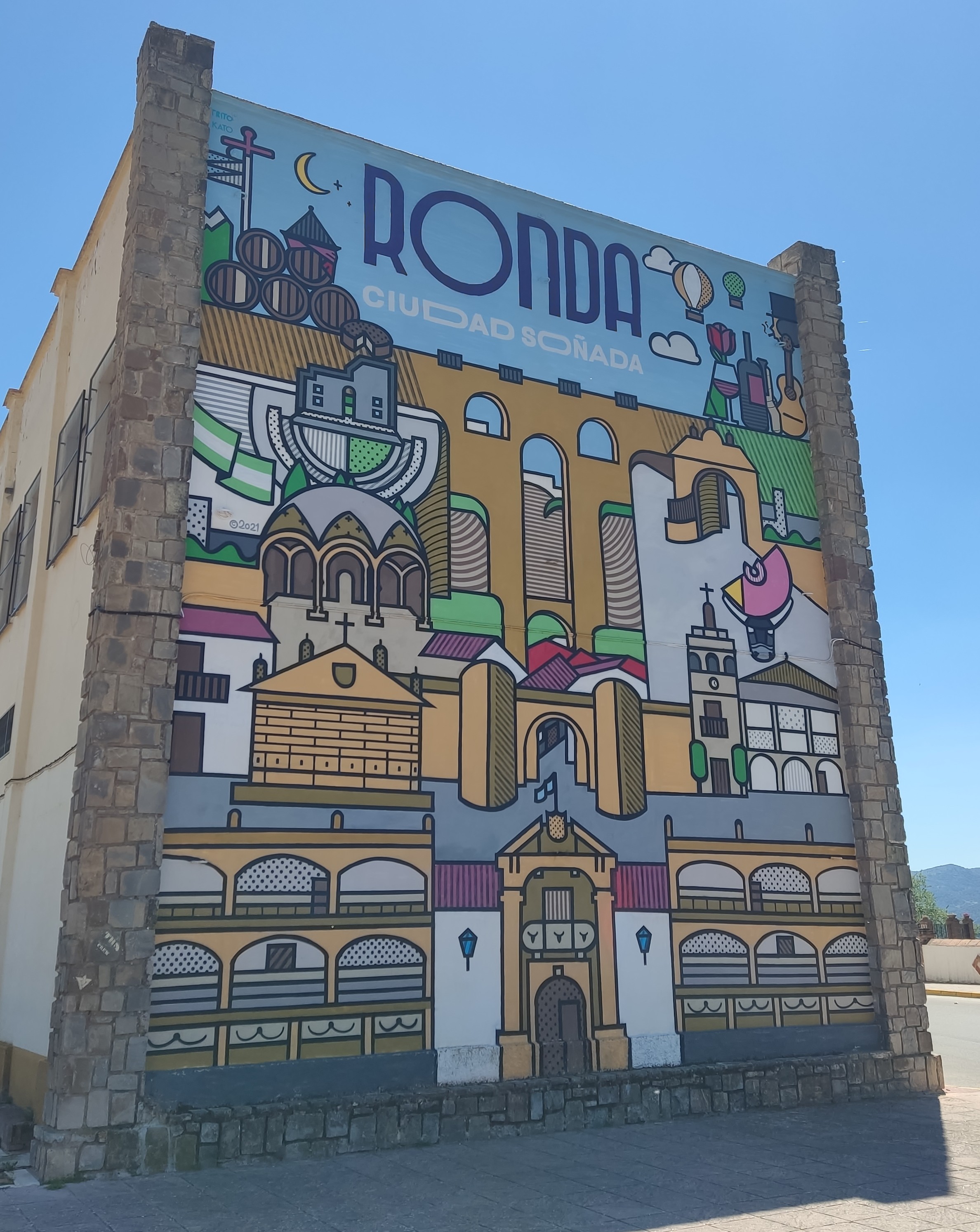 Up into Ronda, past the CEPSA gasolinera, equally as expensive as the afore-mentioned one, and the open-365-days-a-year pharmacy Farmacia Galindo and ahead of you is my favourite of all the murals, a stylised representation of Ronda, featuring all the important landmarks. Fabulous! This was created by rondeño Víctor Fernández. Up into Ronda, past the CEPSA gasolinera, equally as expensive as the afore-mentioned one, and the open-365-days-a-year pharmacy Farmacia Galindo and ahead of you is my favourite of all the murals, a stylised representation of Ronda, featuring all the important landmarks. Fabulous! This was created by rondeño Víctor Fernández.
If you go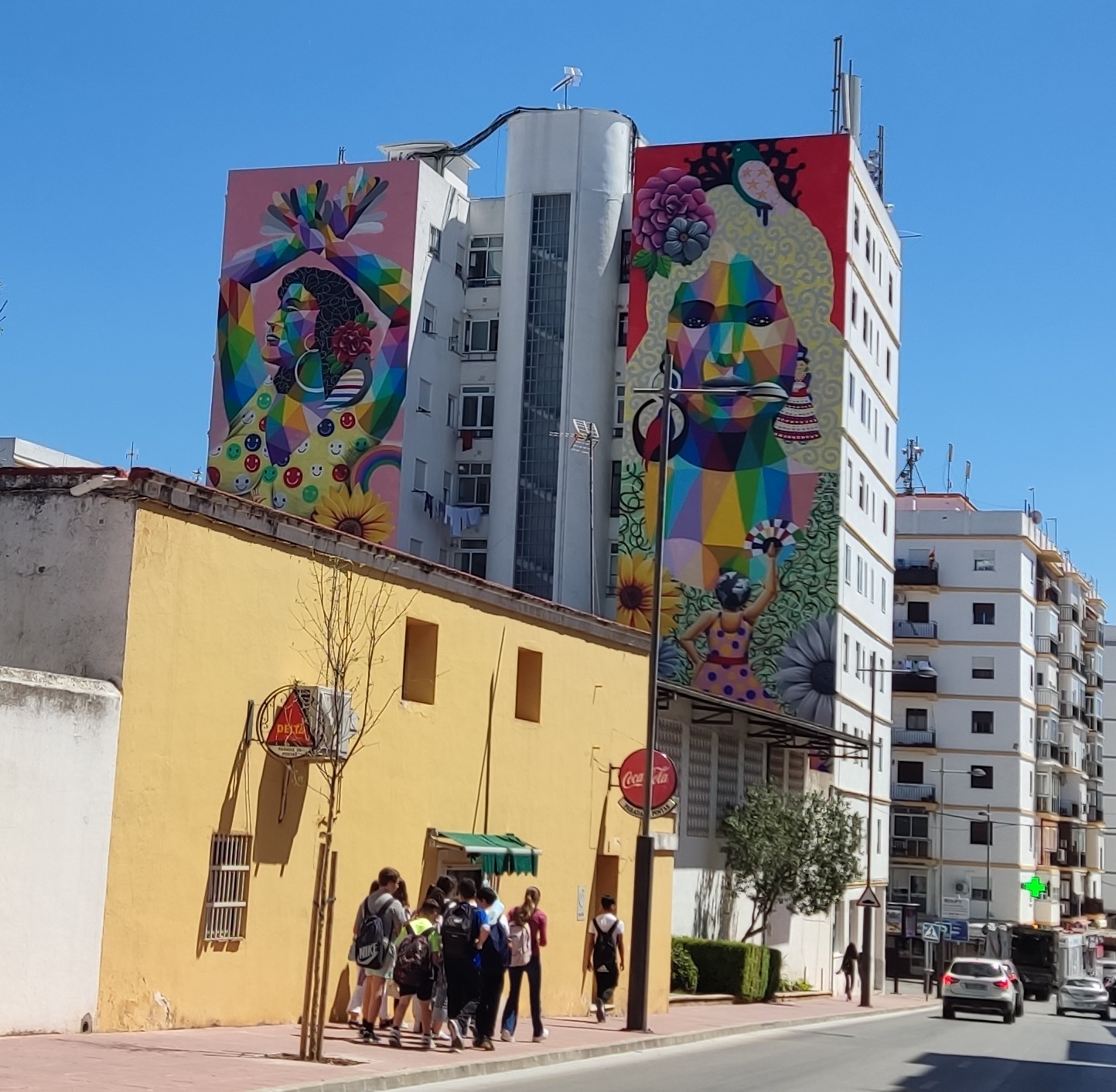 towards the bus station, on the ends of two “skyscrapers” are the first ever murals to grace Ronda. Two ladies in colourful flamenco “gear”. Wonderful! towards the bus station, on the ends of two “skyscrapers” are the first ever murals to grace Ronda. Two ladies in colourful flamenco “gear”. Wonderful!
The artist was Okuda (Óscar San Miguel).
Heading East
Retrace your steps to the big roundabout and head past the Parque de Bomberos, Fire Station, and along the circunvalación, bypass, sign-posted San Pedro de Alcántara 50km. This is the A376.
After 400 metres there is an exit down to the roundabout near LIDL and the white elephant that is the new open-air swimming pool, which is closed for ten months of the year (Rondeños only swim from July to September, coinciding with the schools’ summer vacation).
Here there are two roundabouts in quick succession.
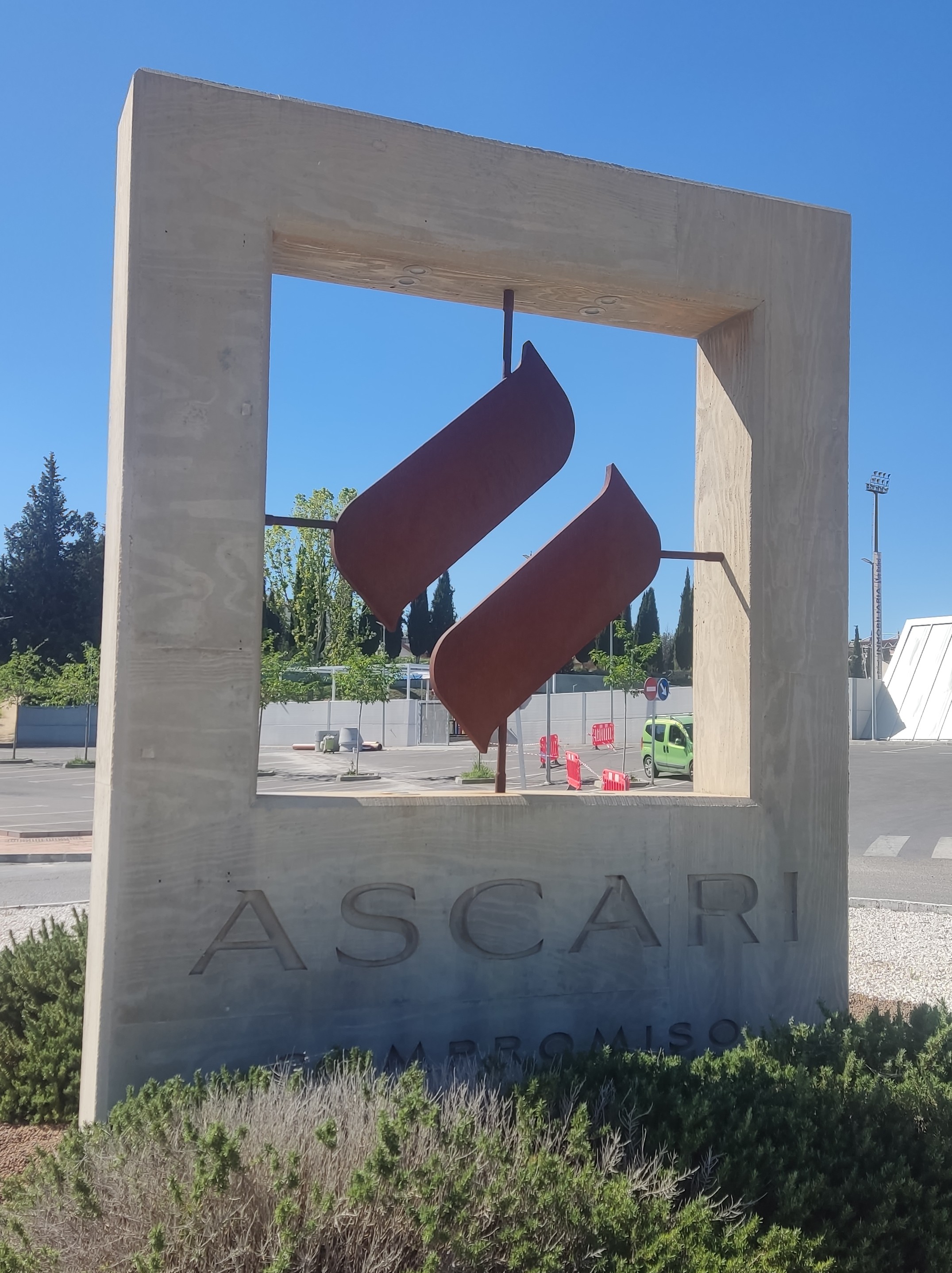 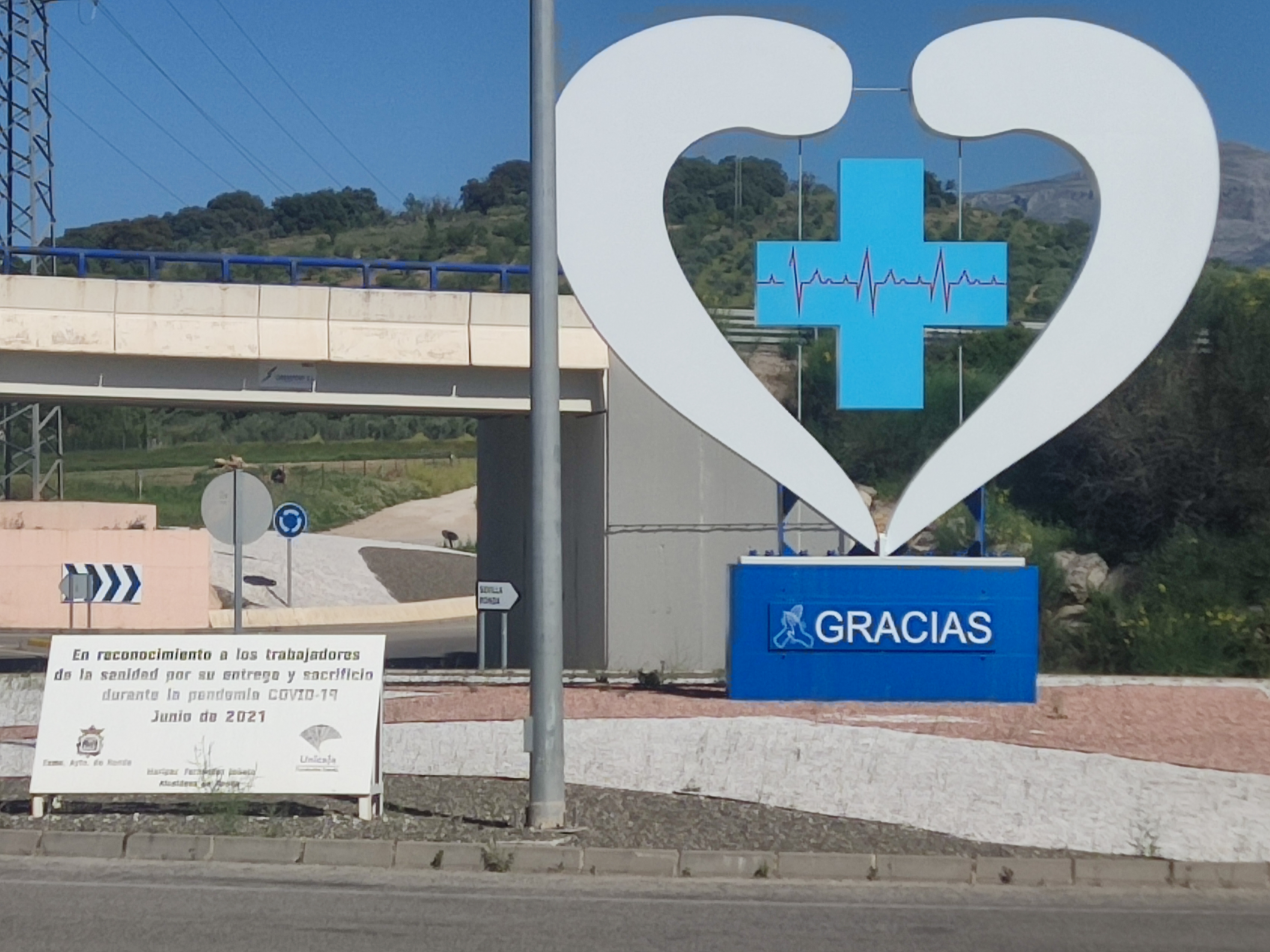 The first has an hommage to those who suffered at the hands of Covid-19, and the second an advertisement for ASCARI, the racetrack on the Campillos Road outside of town. The first has an hommage to those who suffered at the hands of Covid-19, and the second an advertisement for ASCARI, the racetrack on the Campillos Road outside of town.
Strangely, this is dedicated to disgraced Ronda mayor, now deceased, Antonio María Marín Lara, nicknamed Toti. He was found guilty of corruption on a massive scale while in office, yet escaped gaol time.
Well, he was a lawyer. Enough said?
Down South
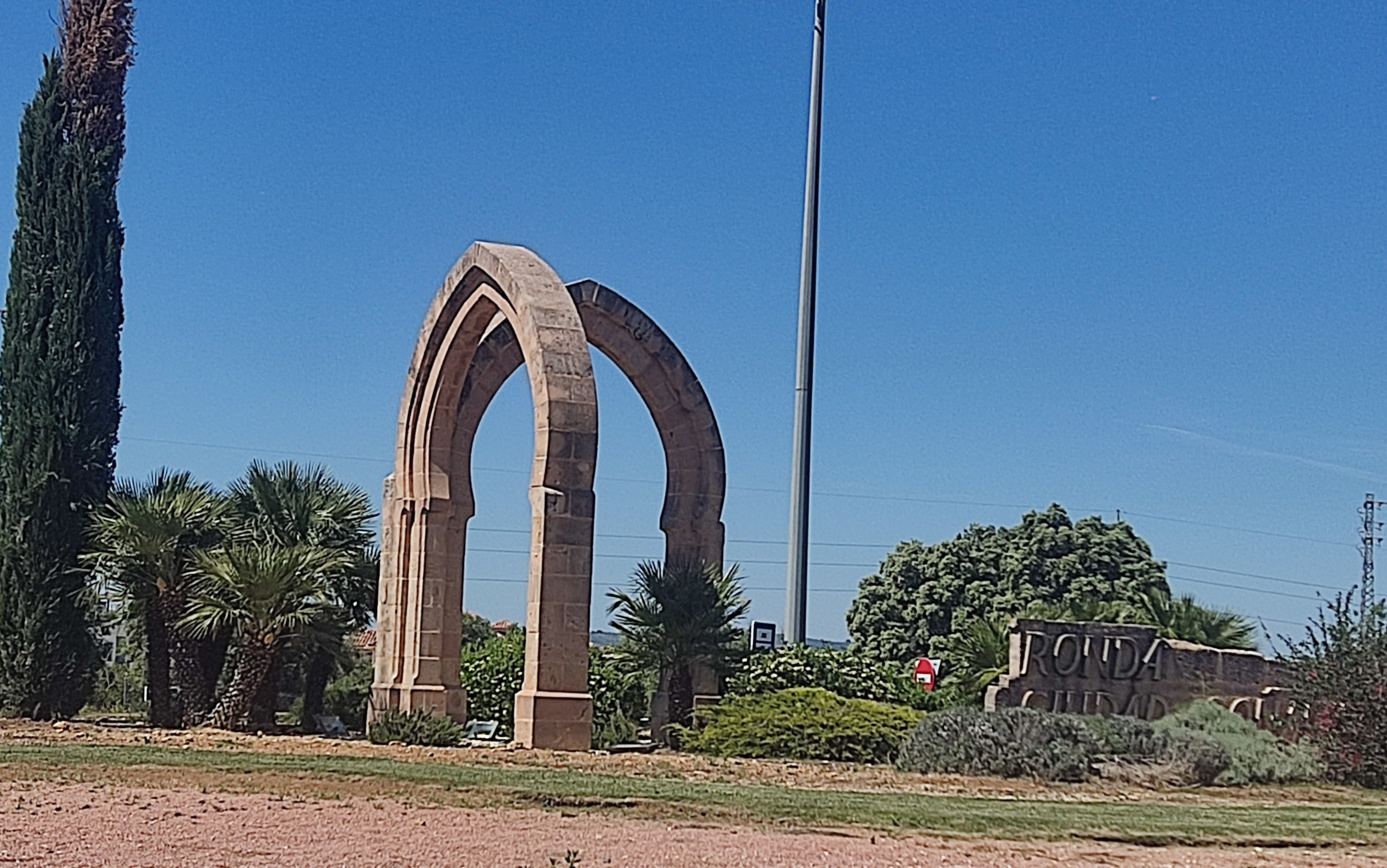 Back on to the A376 heading south, take the exit for Ronda South. On this roundabout stand two Moorish arches and the words Ronda Ciudad Soñada (a reference to Austrian poet Rainer Maria Rilke who lived in Ronda for a time and coined the phrase. Back on to the A376 heading south, take the exit for Ronda South. On this roundabout stand two Moorish arches and the words Ronda Ciudad Soñada (a reference to Austrian poet Rainer Maria Rilke who lived in Ronda for a time and coined the phrase.
 If you keep going into town, at the southern end of the Puente Nuevo opposite Calle Tenorio is a tiled mural that has been around for a few years. A tribute to the Viajeros Románticos (Romantic Travellers), it is a stylised aerial view of Ronda. If you keep going into town, at the southern end of the Puente Nuevo opposite Calle Tenorio is a tiled mural that has been around for a few years. A tribute to the Viajeros Románticos (Romantic Travellers), it is a stylised aerial view of Ronda.
There are quotations from some of these XIX century travellers and writers, including Bécquer, Ford, Irving and Mérimée.
Epilogue
That's it folks! Ronda roundabouts and murals. Although I am The Crazy Guy, I must confess that both the roundabouts and especially the murals enhance the urban landscape of the Ciudad Soñada.
All photographs by Paul Whitelock
© The Crazy Guy
Links:
HELP ME RONDA (eyeonspain.com)
How did Ronda get the name "City of Dreams"? - Help me, Ronda (help-me-ronda.com)
‘St Michael’ comes to Ronda - Secret Serrania de Ronda
Un año sin Antonio María Marín Lara (Toti) | Diario Ronda
Tags:
A367, A376, Antonio Marin Lara, Arikaio, Ascari, Avenida de Malaga, Banksie, Basque, Bienvenidos a Ronda, Campillos, CEPSA, City of the Tajo, Ciudad Soñada, Covid-19, Crazy Guy, Diario Ronda, Farmacia Galindo, globe, grafitti, El Burgo, Help Me Ronda, La Fragua, Moorish arches, mural, Óscar San Miguel, Okuda, Paul Whitelock, Puente Nuevo, Rainer Maria Rilke, Rilke, Romantic Travellers, Ronda, rondeño, roundabout, San Pedro de Alcántara, Secret Serrania, Sevilla, Toti, Viajeros Románticos, Víctor Fernández, Viveros Gomez, www.eyeonspain.com, www.help-me-ronda.com
 2
Like
Published at 7:43 AM Comments (2)
2
Like
Published at 7:43 AM Comments (2)
Andalusien ist schön
Sunday, March 31, 2024
Five of the 10 "most beautiful" provincial capitals in Spain are located in Andalusia, including the first place.
ElectoPanel surveyed 4,000 Spaniards to find out where they see the most beautiful places in the country.
The crown jewel is Seville, which took first place with 14.4% of the votes from people impressed by the mix of Moorish and Gothic architecture, as well as the cultural and gastronomic history.
Granada, with the emblematic Alhambra, the winding streets of the Albaicin and the breathtaking views of the Sierra Nevada, received 13.9% of the vote, securing second place.
With 4.5% of the vote, Cádiz came in sixth, closely followed by Córdoba in seventh place.
And Málaga came in ninth place with 3.6% of the vote.
Fünf der 10 “schönsten” Provinzhauptstädte Spaniens liegen in Andalusien, darunter der erste Platz.
ElectoPanel hat 4.000 Spanier befragt, um herauszufinden, wo sie die schönsten Orte des Landes sehen.
Das Kronjuwel ist Sevilla, das mit 14,4 % der Stimmen von Menschen, die von der Mischung aus maurischer und gotischer Architektur sowie von der kulturellen und gastronomischen Geschichte beeindruckt sind, den ersten Platz belegte.
Granada mit der symbolträchtigen Alhambra, den verwinkelten Gassen des Albaicin und der atemberaubenden Aussicht auf die Sierra Nevada erhielt 13,9 % der Stimmen und sicherte sich damit den zweiten Platz.
Mit 4,5 % der Stimmen kam Cádiz auf den sechsten Platz, dicht gefolgt von Córdoba auf dem siebten Platz.
Und Málaga kam mit 3,6 % der Stimmen auf den neunten Platz.
 0
Like
Published at 6:18 PM Comments (0)
0
Like
Published at 6:18 PM Comments (0)
CAR LITERACY
Sunday, March 3, 2024
 By The Crazy Guy By The Crazy Guy
The letters which appear on our vehicle registrations are fascinating. The ones listed below all have a significance for The Crazy Guy. Let’s take a look!
Provincial Codes – AL, B, CA, CO, GR, H, J, M, MA, SE and SS
From 1900 until 2000, normal car registrations began with the province code where the vehicle was first registered. These cars retained the same number for life, as in the UK, but not in Germany, where change of ownership requires a new registration plate.
That is why we still see older vehicles with the provincial code, viz. Almería, Barcelona, Cádiz, Córdoba, Granada, Huelva, Jaén, Madrid, Málaga, Sevilla and San Sebastián. I chose these because I’ve been to them all and they have personal meanings for me:
Barcelona, the capital of Cataluña, I used to visit quite frequently years ago, for work and for pleasure. The city of Las Ramblas, Gaudi, Parque Guell and Barca is fascinating.
 Madrid, the capital, I’ve been to with work and for pleasure. De Madrid al Cielo, as they say. Plaza Mayor, Parque del Retiro, Museo del Prado and Real Madrid and Atlético Madrid. Fabulous! Madrid, the capital, I’ve been to with work and for pleasure. De Madrid al Cielo, as they say. Plaza Mayor, Parque del Retiro, Museo del Prado and Real Madrid and Atlético Madrid. Fabulous!
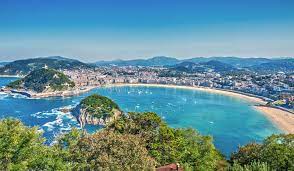 San Sebastián (or Donostia), capital of the Basque province of Gipuzkoa, is where I spent my formative years as a student of Spanish. Playa de la Concha, La Parte Vieja, Monte Igueldo and Real Sociedad FC. The jewel in the crown. San Sebastián (or Donostia), capital of the Basque province of Gipuzkoa, is where I spent my formative years as a student of Spanish. Playa de la Concha, La Parte Vieja, Monte Igueldo and Real Sociedad FC. The jewel in the crown.
***
Cádiz, Córdoba, Granada, Málaga and Sevilla are neighbouring provinces in Andalucia. I love all five capitals. Each different.
Cádiz has its long coastline, the Cámara Oscura and great food and drink (including Spanish real ale!).
Córdoba boasts the Mezquita and its Jewish Quarter.
Granada has the Alhambra and the Sacromonte.
Málaga has Mount Gibralfaro, its Roman Theatre, the refurbished Port Area and Picasso.
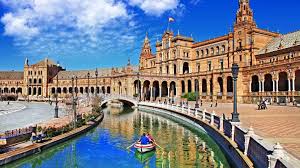
Sevilla is just ….. Sevilla: La Catedral, La Giralda, La Torre del Oro, Plaza de España, Casco Antiguo, and two Primera Liga football clubs, Real Betis and FC Sevilla.
Almería, Huelva, Jaén, the remaining provinces of Andalucía, are places I visited in the past. Great beaches (not in Jaén, obviously!). Almería also has the spaghetti western film set in the desert; Huelva, the estuary of the River Guadalquivir; and Jaén has Úbeda and Baeza, fabulous towns, steeped in history.
Official vehicles – CME, CNP, EA, ET, PGC
CME is Cos dels Mossos d'Esquadra, the Catalán equivalent of the Policía Nacional.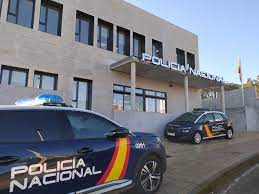
CNP is the Cuerpo Nacional de Policía, or Policía Nacional, the national force responsible mainly for crime.
EA is the Spanish Airforce – Ejército del Aire.
ET is the Spanish Army – Ejército de Tierra.
PGC is the Policía Guardia Civil.
Personal vehicles – DSW, ENJ, GHC, GPM, KBF, KVV, LSL, PJW
2099 DSW was my first Spanish car, a SEAT Leon. What a great car that was! I only sold it because I bought a VW Transporter van, so didn’t need the car any longer.
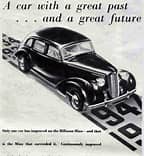 ENJ 406 was our first car when I was growing up in Devon in the 1950s. It was a Hillman Minx saloon with split windscreen and running boards. It had apparently been an army staff car in the Second World War. My dad shelled out ….. a massive 125 pounds for it! ENJ 406 was our first car when I was growing up in Devon in the 1950s. It was a Hillman Minx saloon with split windscreen and running boards. It had apparently been an army staff car in the Second World War. My dad shelled out ….. a massive 125 pounds for it!
5435 GHC was Rita’s Peugeot 206 cabriolet which she bought new in Germany and imported to Spain when she emigrated here in 2006. Sadly, the engine caught fire in 2021 and the car had to be scrapped.
7621 GPM was Rita’s replacement car, a Peugeot 207 cabriolet, which we bought in Madrid.
YB54 KBF is the Volkswagen Transporter T20 van I bought from my neighbour, JM, who some months later in a fit of spite, set it alight and wrote it off (allegedly). The police know he did it, but there was no proof.
8130 KVV is my current car, a Peugeot 2008.
1142 LSL is the number I was allocated when I legalised the VW Transporter by officially importing it and re-registering it here in Spain.
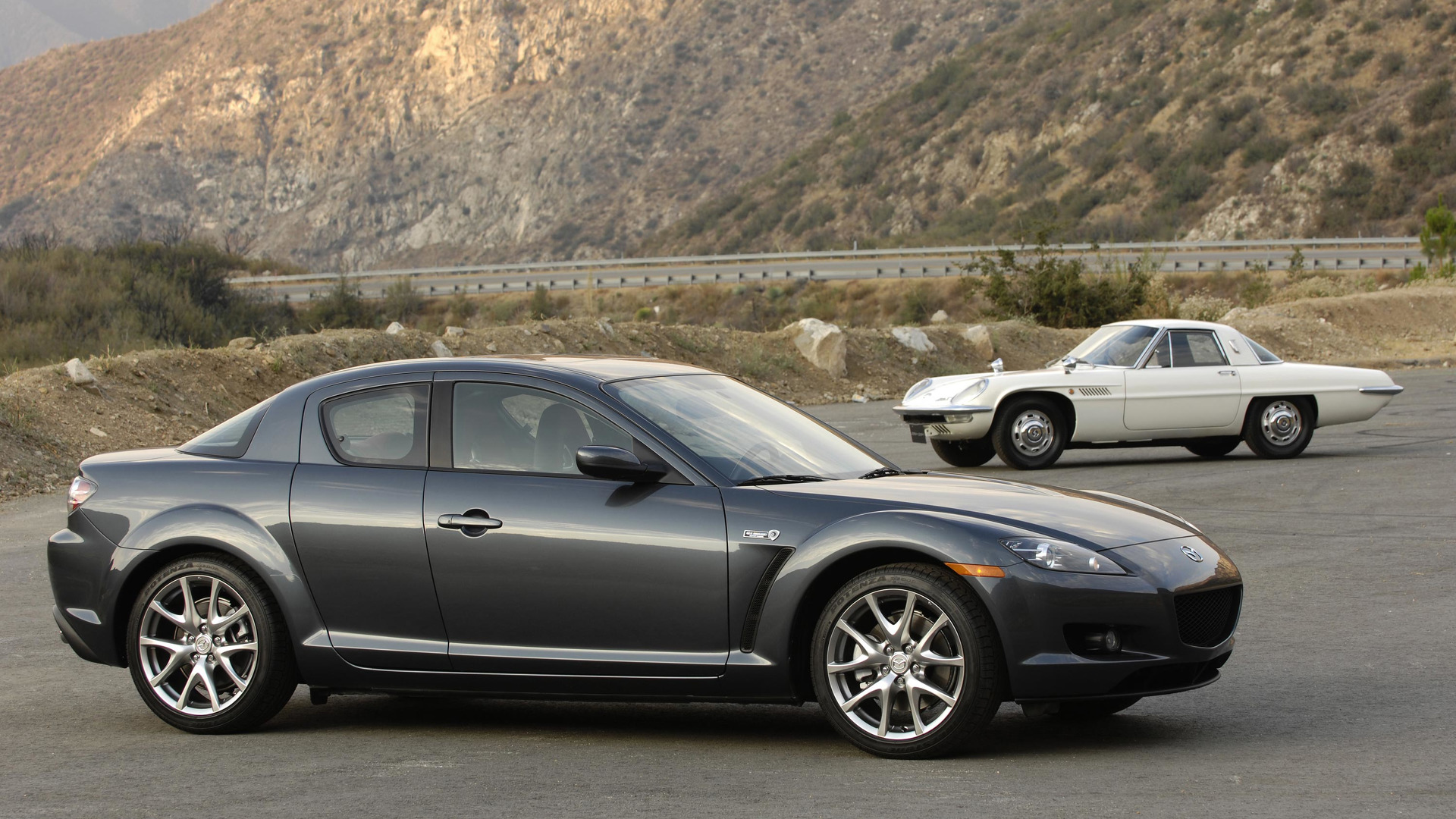 M50 PJW is the personalised registration (cherished number plate) to which I treated myself when I reached 50 years of age and bought a Mazda RX8, the best car I ever had. M50 PJW is the personalised registration (cherished number plate) to which I treated myself when I reached 50 years of age and bought a Mazda RX8, the best car I ever had.
This was a sports car with a Wankel rotary engine. I loved my “male menopause” purchase. When I got through said “menopause, I sold the Mazda and a bought a somewhat boring Ford Focus onto which my cherished number was transferred.
I sold the Focus when I bought a Vauxhall Vivaro van, which I needed while doing up my house in England and when I emigrated to Spain. I sold the Vivaro van to my German pal Rainer, who made me a good offer. He exported it to Germany, where he and his missus Iris, used it for many years. Sadly, I hear it is no longer going strong!
Note: I can’t include the reg. no. of the Vivaro, simply because I can’t remember it and no longer have any paperwork.
Conclusion
So, there we have it. The vehicle registration letters that have been important in my life, from Spanish provincial markers, through official Spanish vehicles to my privately-owned cars and vans, both in the UK and in Spain.
© The Crazy Guy
Acknowledgements:
civitatis
guardia civil
jdpower.com
Paul Whitelock
Tags:
Almería, Alhambra, Andalucia, army staff car, Atlético, Barca, Barcelona, Basque, cabriolet, Cádiz, Cámara Oscura, car registration, Casco Antiguo, Cataluña, Catedral, cherished number, Córdoba, Cos dels Mossos d'Esquadra, CME, CNP, Cuerpo Nacional de Policía, De Madrid al Cielo, Donostia, EA, ejército del Aire, ejército de Tierra, ET, FC Sevilla, Ford Focus, Gaudi, Gibralfaro, Gipuzkoa, Giralda, Granada, Guadalquivir, Guardia Civil, Hillman Minx, Huelva, Jaén, La Parte Vieja, Las Ramblas, Madrid, Málaga, male menopause, Mazda RX8, Mezquita, Monte Igueldo, Museo del Prado, Parque del Retiro, Parque Guell, Parte Vieja, Paul Whitelock, personalised registration, Peugeot 2008, Peugeot 206, Peugeot 207, PGC, Picasso, Playa de la Concha, Plaza de España, Plaza Mayor, Policía Nacional, Primera Liga, province code, Real Betis, Real Madrid, Real Sociedad FC, registration, rgistration plate, Roman Theatre, running boards, Sacromonte, San Sebastián, SEAT Leon, Second World War. Sevilla, spaghetti western, split windscreen, Torre del Oro, Úbeda, Vauxhall Vivaro, Volkswagen Transporter T20, VW Transporter, Wankel rotary engine.
 3
Like
Published at 10:55 AM Comments (1)
3
Like
Published at 10:55 AM Comments (1)
10,000 steps a day? Rubbish!
Thursday, January 18, 2024
By The Crazy Guy
 In order to keep fit and healthy and to prolong our lives, we are supposed to take 10,000 steps a day, say medical experts. “Rubbish!” says The Crazy Guy, not one to blindly accept everything we are told. In order to keep fit and healthy and to prolong our lives, we are supposed to take 10,000 steps a day, say medical experts. “Rubbish!” says The Crazy Guy, not one to blindly accept everything we are told.
Photo courtesy of Protein2o
Los increíbles beneficios de andar
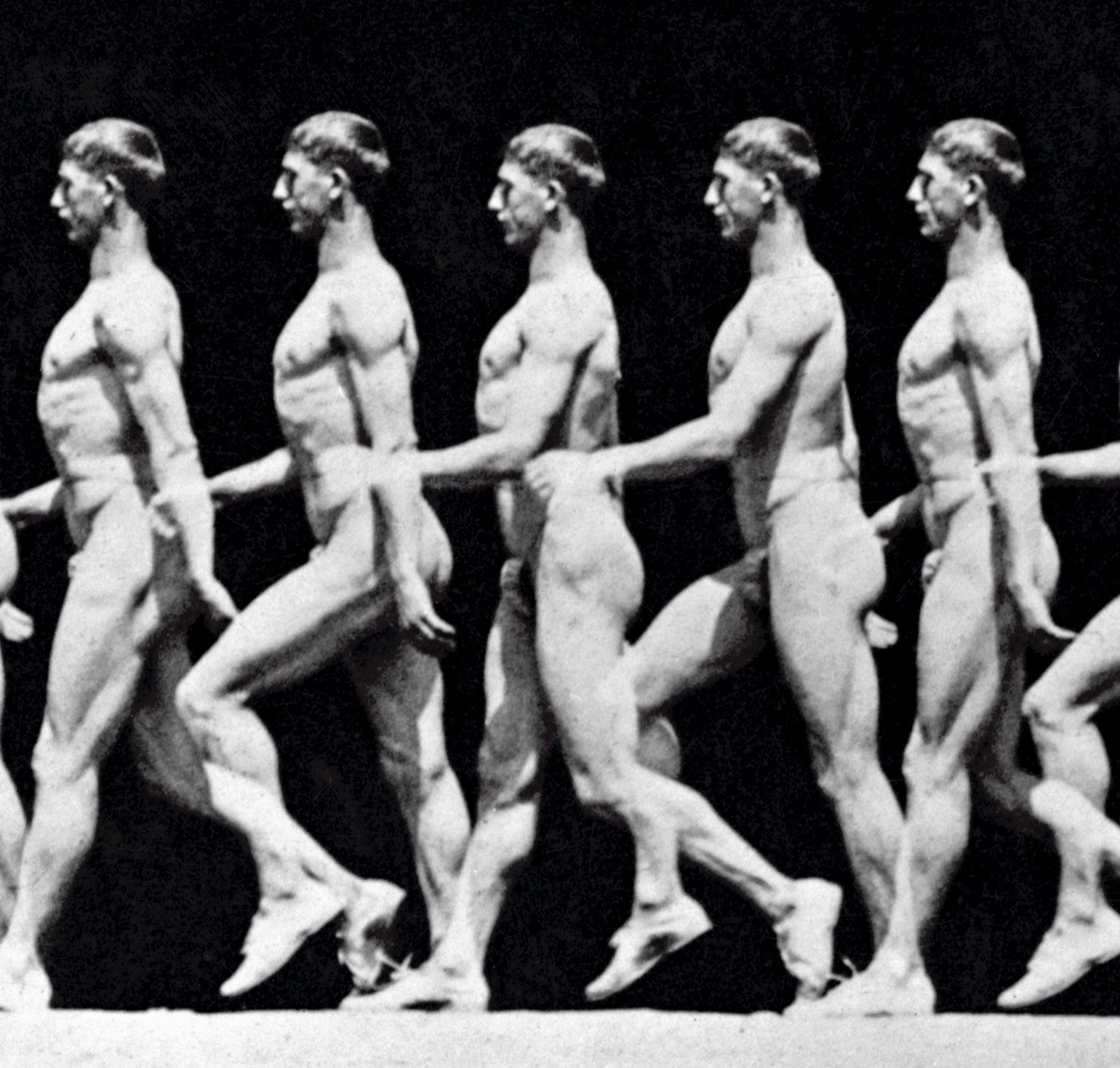
In her recent article in XL Semanal Raquel Peláez argued that “Caminar te va a salvar la vida” (Walking is going to save your life).
“Several scientific studies have shown that the physical and mental benefits of walking are immediate,” she wrote. “Never mind achieving 10,000 steps a day, every minute spent walking counts.”
This all stems from the fact that our species is unique in that we are upright animals, bi-peds. This allowed human beings to use their fore-legs, ie arms, for other purposes, such as carrying things, making things, using their hands. But on top of this it enabled us to put one foot in front of the other, to walk, which is the most easily achievable movement at our disposal.
Photo courtesy of XL Semanal
Prolong your life
According to scientists, people who walk live longer, have better balance, are happier and more intelligent. Several scientifioc studies have shown that there is no other form of exercise that has such a positive, strengthening and healthy effect on both body and mind as walking.
According to the latest study, carried out by researchers at North Western University in Illinois, USA, and published in the summer of 2023, in people over 40, modest physical activity is the most significant factor influencing health and longevity. Walking, together with a healthy diet and sufficient sleep, can reduce the chance of a premature death by 30 per cent in this age group.
The Unidad de Investigación de Atención Primaria at the University of Bizcaya in Bilbao has found that a small increase in physical exercise, eg fast walking for 50 minutes a week (less than eight minutes a day) reduces by 31 per cent the risk of a premature death amongst people who have led a sedentary life for decades .
On top of that, th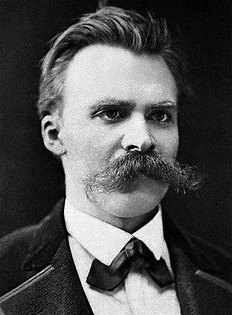 e number of steps per day required to start to notice a difference in one’s health, is far fewer than the mythical 10,000 steps. According to scientists at John Hopkins University in Maryland, USA, 4,000 steps are sufficient to start to reduce the risk of premature death. Indeed, this study indicates that 2,300 steps are sufficient to benefit the heart and blood vessels. e number of steps per day required to start to notice a difference in one’s health, is far fewer than the mythical 10,000 steps. According to scientists at John Hopkins University in Maryland, USA, 4,000 steps are sufficient to start to reduce the risk of premature death. Indeed, this study indicates that 2,300 steps are sufficient to benefit the heart and blood vessels.
During walking the body produces two neurotransmitters, endorphins and dopamine, the happiness hormone and the creative hormone respectively, which combat stress, prevent depression, and regularize sleep patterns. A study by Stanford University (California, USA) supports this argument by their discovery that walking increases creativity in a person by an average of 60 per cent.
As the German philosopher, Friedrich Nietzsche wrote: “A sedentary lifestyle is the real sin against the human spirit.”
Photo of Friedrich Nietzsche courtesy of Wikipedia
Benefits of walking

After 10 seconds - with every step the deep musculature in the body is activated and has a beneficial effect on the vertebrae and disks in the back.
After 5 minutes - even a short daily walk has a positive effect on our life expectancy.
After 11 minutes - you have burned 50 kilocalories, so in a week 350. According to a report by Cambridge University (UK), walking 11 minutes a day can help reduce cardiac disease, cerebro-vascular accidents, and certain types of cancer.
Photo courtesy of Henry Ford Health
After 12 minutes - exposure to 12 minutes of sunshine brings sufficient Vitamin D, vital for the metabolism, absorbing calcium and phosphates in the gut and for healthy bones.
After 20 minutes - great for reducing stress, relaxing muscles and the nervous system, and lowering blood pressure. It also helps us sleep better.
After 30 minutes - walking for half an hour per day for five days a week reduces the risk of heart disease by 19 per cent. The body starts to secrete serotonin, the happiness hormone. According to cardiologists we should walk for 30-40 minutes every day, preferably in the early evening, when our walk can improve our physical capacity, our metabolism and our blood pressure.
After 45 minutes - leading a more active life helps prevent colds. The University of South Carolina (USA) found that after a year of physical activity the average number of colds suffered by previously sedentary people fell by 23 per cent.
After 60 minutes - an hour's walk a day reduces the risk of suffering depression, according to a study by the University of South Australia which lasted 11 years and with 34,000 participants. A Japanese study concluded that a walk in the countryside is preferable to one in the town.
Acknowledgements:
Raquel Peláez
XL Semanal
Tags:
10,000 steps a day, Cambridge University, Crazy Guy, dopaminbe, endorphin, Friedrich Nietzsche, John Hopkins University, North Western University in Illinois, Raquel Peláez, Stanford University, Unidad de Investigación de Atención Primaria, University of Bizcaya, University of South Australia, University of South Carolina, Vitamin D, Wikipedia, XL Semanal,
 1
Like
Published at 10:45 AM Comments (0)
1
Like
Published at 10:45 AM Comments (0)
All you needed to know about The Crazy Guy.
Thursday, January 4, 2024
By The Crazy Guy
The Crazy Guy has two blogs on Eye On Spain, one eponymous and the other about "How to ....." do various things here in Spain.
The Crazy Guy is an alias for Paul Whitelock, which is no real secret.
Paul has several other noms de plume on Eye On Spain, depending on the theme of the blog.
THE CRAZY GUY

The Crazy Guy is known amongst the Spanish people where he lives as "El Loco", largely because, despite his advanced age, he's always active, doing this and that. So, he's "The Crazy Guy".
This blog is about some of the things he's been getting up to lately.
The Crazy Guy (El Loco, according to his fellow villagers) likes to keep busy. He hopes readers of this blog find his experiences interesting.
He has another blog on EOS called "How to .....?" which offers advice on how to do things here in Spain, based on his experiences.
HOW TO ..... ?
 This blog is intended to be helpful to English-speaking foreign residents in Spain by explaining "how to ... " do certain things. This blog is intended to be helpful to English-speaking foreign residents in Spain by explaining "how to ... " do certain things.
The Crazy Guy has lived in Spain full time since 2008. A fluent Spanish-speaker he reckons he knows his way round the bureaucracy, the indifference and sometimes downright rudeness of "funcionarios".
The Crazy Guy is known amongst the Spanish where he lives as "El Loco", largely because, despite his advanced age, he's always on the go, doing this and that. The Crazy Guy hopes his "How to ..." articles will be helpful to others.
ONLY JOE KING
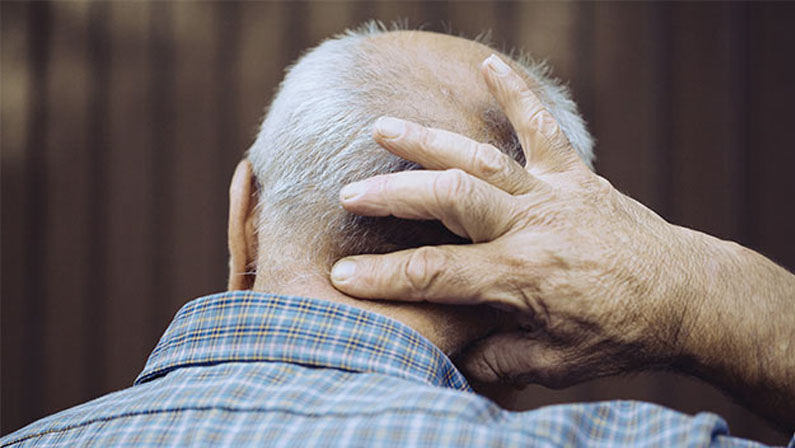
A light-hearted look at life in Andalucía and Spain in general; its good points and its bad. This blog doesn't pull any punches.
Only Joe King didn't really want anybody to know anything about him. That's just gone out of the window, BTW.
He's blogging because he thinks he has valid things to say. He hopes readers appreciate the pun in the name (Only joking!).
MY COVID-19 DIARY - MARCH 2020 TO DATE
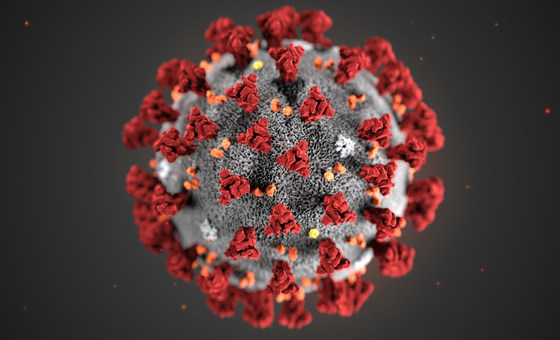 The coronavirus pandemic has hit the world hard, with over 120 million global victims. The coronavirus pandemic has hit the world hard, with over 120 million global victims.
I am British, married to a German and we live in Andalucía in the Serranía de Ronda.
This blog contains articles i've written since we both caught Covid-19 at the beginning of 2020. It was a weird life of curfews, lockdowns, masks, hand gel, rules and regulations and, for those of us who were affected directly, the vicious after-effects of the virus, long-covid, bereavement and financial ruin.
I started this blog in the aftermath of our personal experiences with the Coronavirus. Hopefully it has run its course, ie both Covid and this blog.
SPANISH MATTERS - A BLOG IN ENGLISH AND SPANISH FOR THOSE LEARNING THE LANGUAGE

This blog is entitled "Spanish Matters", because it does!
Matter, that is.
If you have committed to living in Spain, in my opinion you should also make a commitment to learn some Spanish. Your life will be enhanced.
So this is a blog about matters Spanish, as well as promoting the notion that Spanish does indeed matter.
The blog contains articles in both English and Spanish. I hope it will be helpful to those learning the language.
The name Don Pablo betrays my origins as a former Spanish (and German) teacher in the UK.
This blog will continue to be added to from time to time.
PUNTOS DE VISTA - A PERSONAL SPAIN BLOG
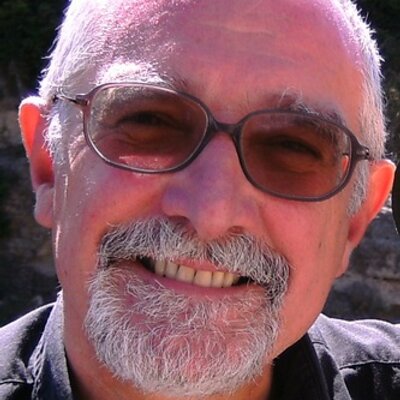
Musings about Spain and Spanish life by Paul Whitelock, hispanophile of some 45 years and resident of Ronda in Andalucia for the last 15 years.
This is my main blog, indicated by the number of posts I have made, already well in excess of 100.
SERRANÍA KITCHEN - RECIPES FROM AROUND THE WORLD

This blog contains a selection of recipes from all over, in particular from Andalucía, Asia, England, Germany and the wider Mediterranean area.
Contributors include Rita Drechsler, Jovan Le Knorz, Madita Schröder, Carolyn Emmett, Simon Whitelock, Julie Wilkinson and Paul Whitelock, who are mostly members of the same extended Anglo-German family.
Rita and Paul, Carolyn, and Julie all live in the Serranía de Ronda in Andalucía.
Madita and Jovan live in Baden-Württemberg, near Heilbronn, Germany.
Simon lives near Bristol, in the UK.
THE CULTURE VULTURE
A blog 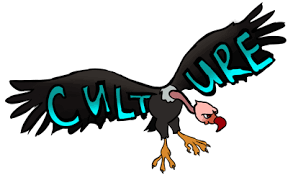 about cultural things: art, music, dance, literature, film and theatre. about cultural things: art, music, dance, literature, film and theatre.
The Culture Vulture enjoys the good things in life. These include art, music, dance, film, theatre, and books.
THE CURMUDGEON
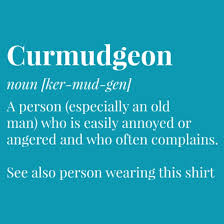
The Curmudgeon is a miserable sod. He likes to have a moan. He tackles subjects which many foreigners living in Spain agree with but are too polite to say anything about.
The Curmudgeon is now in his early 70s now and has lived in the Serrania de Ronda since he was 58.
THE HISTORY MAN
This blog co ntains interesting facts about the history of Spain and things Spanish. ntains interesting facts about the history of Spain and things Spanish.
The History Man discovered Spain some 50-odd years ago and he fell in love with the place. He has been resident here for 15 years and takes a keen interest in all things historical, geographical and cultural.
He is blogging because he hopes readers will find what he writes interesting.
THE SPANISH FLY - TRAVELS IN SPAIN AND BEYOND
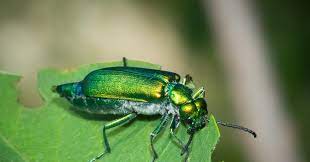
The Spanish Fly is a nom de plume of Paul Whitelock who first visited Spain at the age of 20. Now more than 50 years later, he has been to most parts of the country, including nine of the 12 islands. He has owned property in Andalucía since 2001 and has lived in the region for the last 15 years. This blog is a travelogue about some of the places he has visited.
The Spanish Fly writes keenly about his travel experiences in Spain and beyond. He hopes you enjoy sharing his journeys and are inspired to make similar ones yourself.
***
EPILOGUE
So, now you know. All of these blogs are written by li'l ol' me, Paul Whitelock.
I hope you enjoy reading them. Please feel free to comment.
© Paul Whitelock
Tags: Andalucia, blog, blogger, Coronavirus, Covid-19, Crazy Guy, Culture Vulture, Curmudgeon, Don Pablo, El Loco, EOS, Eye on Spain, History Man, How to .....?, Joe King, noms de plume, Only Joe King, Paul Whitelock, Puntos de Vista, Serrania Kitchen, Spanish Fly, Spanish Matters
 0
Like
Published at 12:27 AM Comments (0)
0
Like
Published at 12:27 AM Comments (0)
The Houses That Jack Built - update
Thursday, October 5, 2023
By The Crazy Guy
The Crazy Guy, known by the Spanish locals as "El Loco", was a languages teacher, a school inspector and a translator and interpreter. Since retirement over 18 years ago he has also dabbled in journalism and blogging.
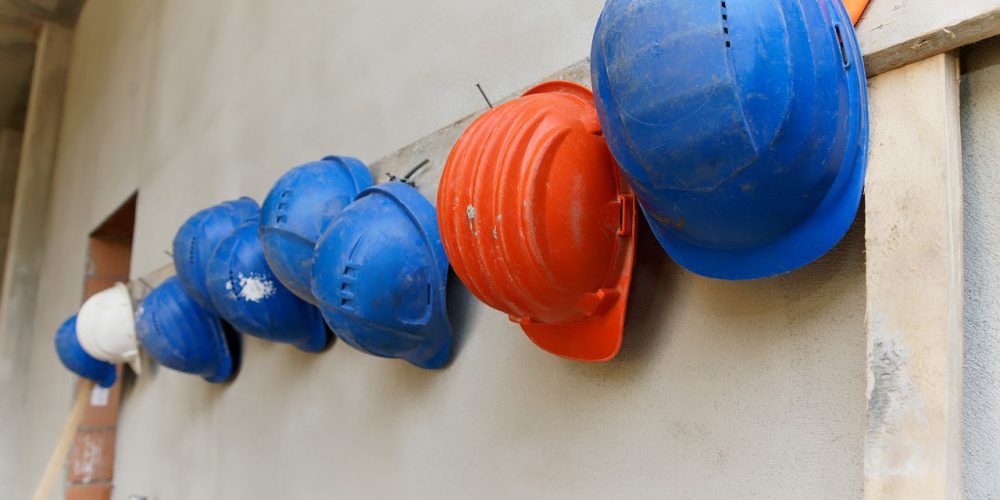 But what he really wanted to do when he was younger was to be a tradesman, eg. plumber, electrician, carpenter, bricklayer, tiler or painter and decorator. Over the years he’s had a go at all of these on an amateur, DIY basis with relative success. But what he really wanted to do when he was younger was to be a tradesman, eg. plumber, electrician, carpenter, bricklayer, tiler or painter and decorator. Over the years he’s had a go at all of these on an amateur, DIY basis with relative success.
Here’s the story of the houses that Jack – The Crazy Guy - built! Or helped to build…..
Photo courtesy of Karl Smallman
First steps
I first started doing bits and pieces of DIY when I was a poorly paid young teacher. My wife Jeryl and I bought our first house, a semi-detached in Walkden, Greater Manchester, for £11,000. A lot of money back then and the mortgage interest rate was around 16 per cent!
Unable to afford to employ professionals, I informed myself from books (no YouTube videos back then in the late 1970s) and tentatively did a bit of electrical work, plumbing and painting and decorating, aided and abetted by Jeryl. We were childless then, so no distractions.
After about three years we sold up and moved to our second house, in Thelwall, Warrington, not far from the infamous Thelwall Viaduct on the M6. A three-bed detached it cost us just £37,500, a huge amount in 1980.
Over the next 20 years, the house grew in size to become a four-bedroomed, two bath-roomed house with four reception rooms and a third WC, plus a garage and a large balcony overlooking the adjacent park.
Although builders did the main construction work, my DIY skills had developed so much that I was able to re-wire the whole house, convert the original garage into an extra lounge-cum-music room, turn the separate toilet and bathroom into an ensuite bathroom with new suite, install a shower, replace all the guttering and drainpipes and build two patios and a pergola. Not to mention wall-papering and painting throughout. I even built a tree house for my two kids.
Houses in Spain, Wales and Luxembourg
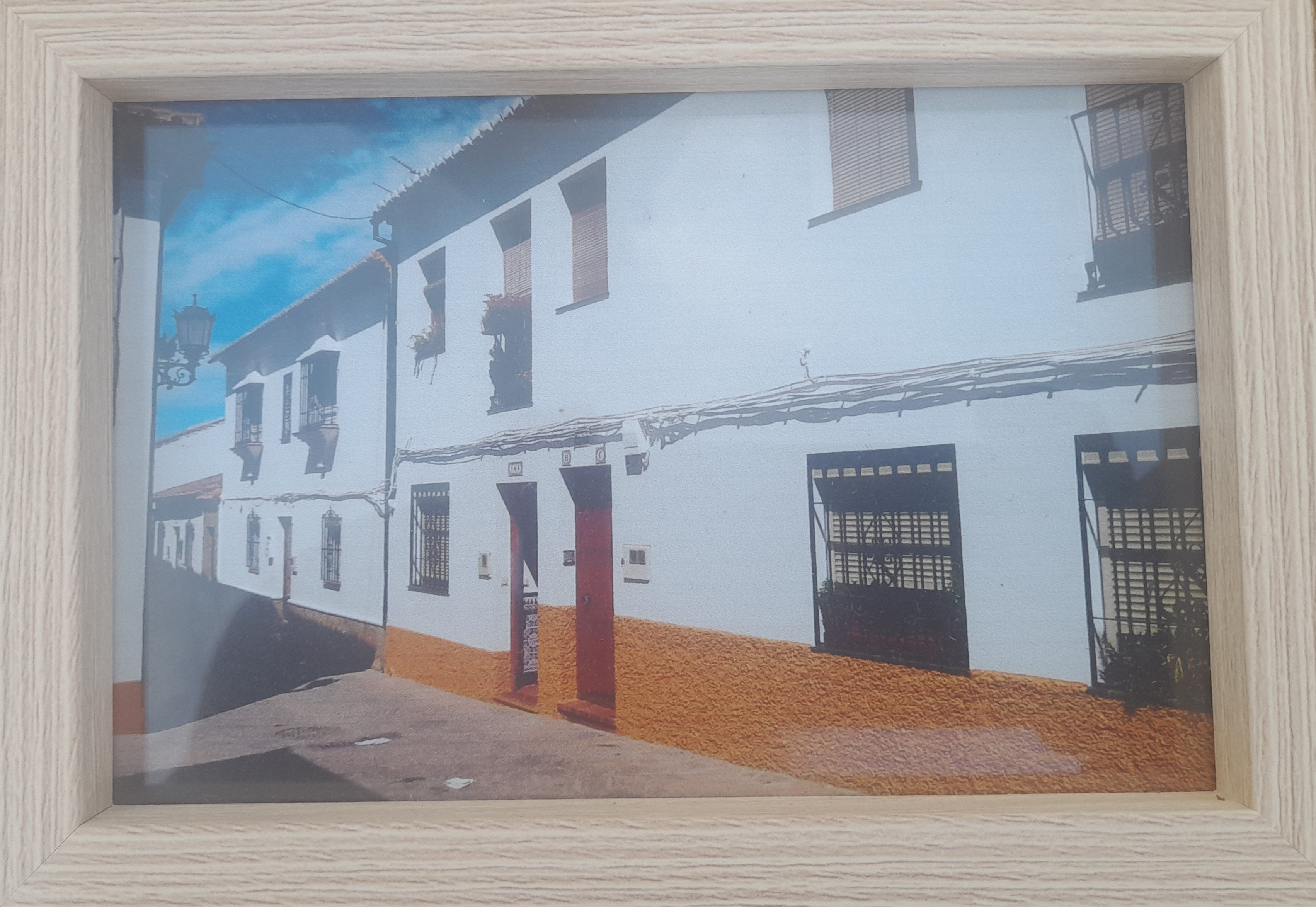 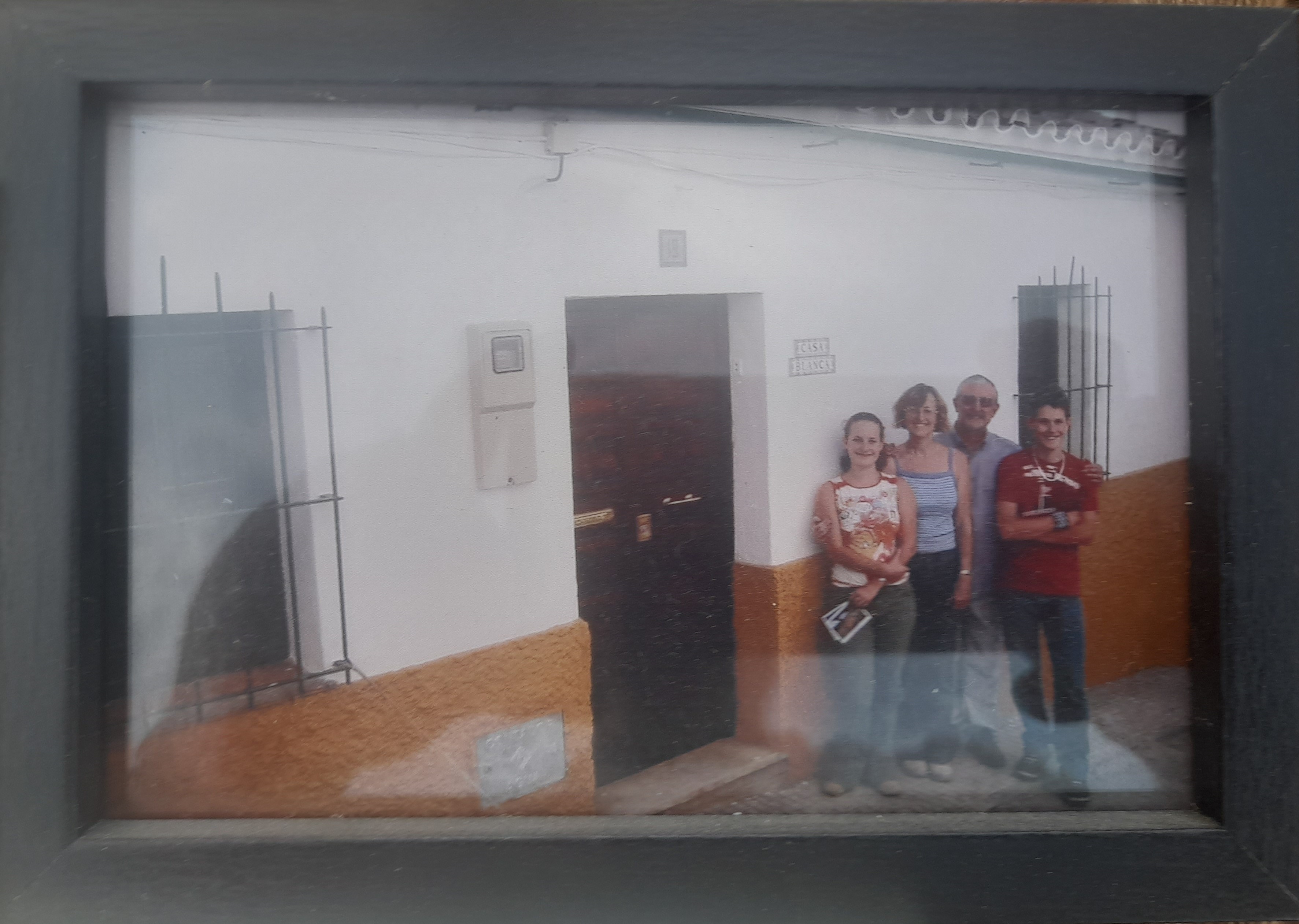 In the early 2000s Jeryl and I bought two properties in relatively quick succession in Ronda, Andalucia. The first, Piso Blanco, was a small flat that needed little doing to it, but the second, an end-terraced house, which we named Casa Blanca, was virtually a ruin. In the early 2000s Jeryl and I bought two properties in relatively quick succession in Ronda, Andalucia. The first, Piso Blanco, was a small flat that needed little doing to it, but the second, an end-terraced house, which we named Casa Blanca, was virtually a ruin.
Over the next couple of years, I re-wired it, replaced a collapsed floor, upgraded the kitchen, re-built the terrace and decorated throughout.
Then disaster struck, or should I say three disasters!
Redundancy, early retirement and divorce in quick succession, in 2005, saw me living with a new lady, Maude, a wido, in her beautiful cottage in Bryn-y-Maen, North Wales.
I did a few bits and pieces there to keep my hand in and then, when I took her to Ronda for a long weekend, Maude bought a small house there on the spur of the moment.
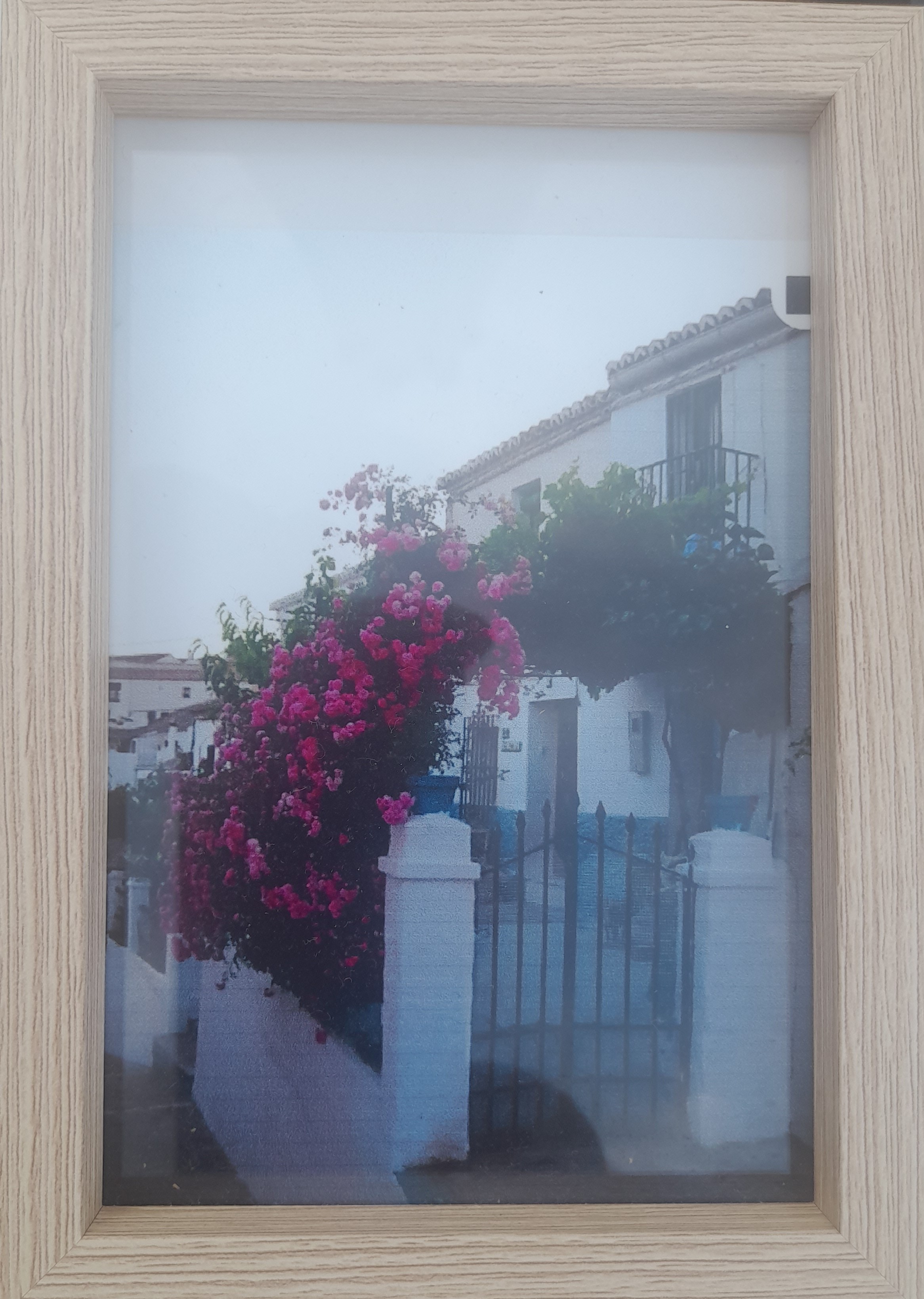 We called it El Rincón because it was tucked away in a corner. It needed a lot of work, which I happily took on. Maude was still working full time in the UK, but I was retired so spent months in Ronda re-wiring, building a new bathroom, tiling floors and creating a rather delightful, terraced garden at the rear of the house. A good lick of paint and El Rincón was finished. We called it El Rincón because it was tucked away in a corner. It needed a lot of work, which I happily took on. Maude was still working full time in the UK, but I was retired so spent months in Ronda re-wiring, building a new bathroom, tiling floors and creating a rather delightful, terraced garden at the rear of the house. A good lick of paint and El Rincón was finished.
The end of the relationship with Maude put paid to my DIY activities for a couple of years, until an old university friend, Jac, who lives in Luxembourg, invited me to spend the summer of 2008 in the Grand Duchy helping her daughter and son-in-law renovate an old house they’d bought there.
That was great fun and I developed some new skills, as building practices there differ significantly from the ones I had become familiar with in the UK.
Back to Warrington
After that busy but enjoyable summer of 2008 I was foot-loose and fancy-free again, so headed off to Ronda to stay in Piso Blanco for a few days, prior to moving into a house in Latchford, Warrington, which I’d bought with the proceeds from the sale of Casa Blanca, the Ronda house I’d done up a few years before.
The Warrington house was a real bargain. Tunstall Villa, as the “new” house in Latchford was named, was a “do-er up-er”. A Victorian detached villa, rather down on its luck, it had the potential to be a great house again. It only cost me £119,000.
Still “unemployed” - by this time I’d been retired for three years - I had plenty of time on my hands, so I set about the renovation. Over many months I created a delightful winter garden, renovated the rear internal area to provide a WC and laundry room, re-decorated throughout, and then, after two and a half years ….. I sold it!
Why on earth …..?
Back to Andalucia
Well, on that visit to Ronda in September 2008 that I mentioned earlier, I’d met a lady I nicknamed the “Meter Maid”! Yes, you guessed it, her name is Rita. We dated in Spain, the UK and Germany, where she is from, and quickly fell in love.
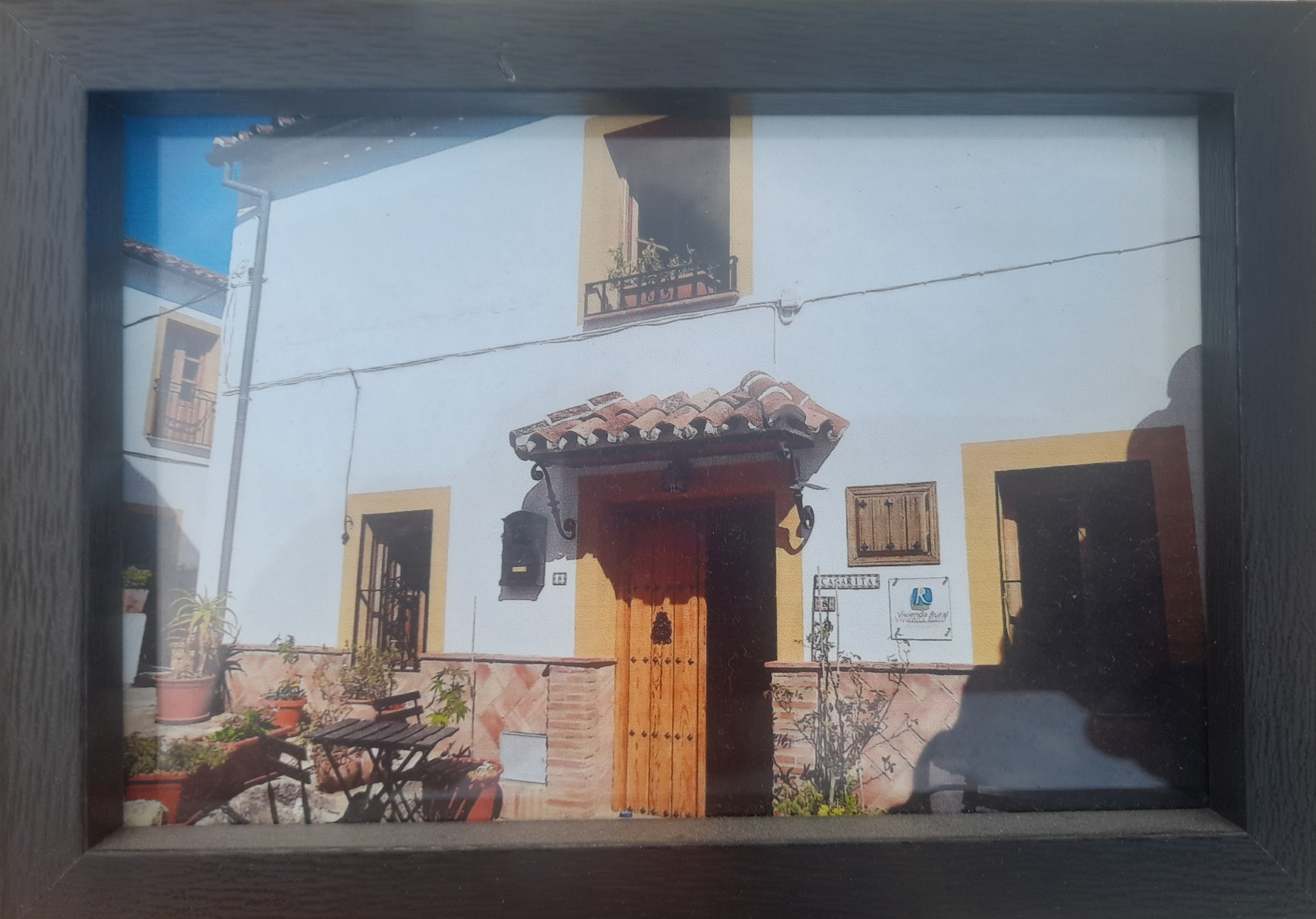 I immigrated to Spain at the end of that year to live with Rita in her lovely village house, Casa Rita, in Montejaque. In 2010 we married. I immigrated to Spain at the end of that year to live with Rita in her lovely village house, Casa Rita, in Montejaque. In 2010 we married.
The DIY didn’t stop, however! I built a kitchenette in a bedroom in Casa Rita, that we set up as a B & B, and handled all the maintenance work there.
Both having committed to living in Spain, we needed a house that better met the needs of our respective families, eg her disabled grandson, my ailing mother. So, I sold Tunstall Villa in Latchford and we used the money from the sale to buy our dream house in the campo just outside Ronda.
.jpg) That house is known as Villa Indiana. That all happened in 2011, the year after we “jumped the broom” and we still live there after 13 years of married life. That house is known as Villa Indiana. That all happened in 2011, the year after we “jumped the broom” and we still live there after 13 years of married life.
The DIY and gardening have continued, of course, although, as I get older, I rely a bit more on local tradesmen to keep on top of things.
In 2019 I decided to sell Piso Blanco in Ronda after 18 years’ ownership. We had been using it as a holiday rental, but all of a sudden the bookings started to dry up, so it had to go.
In October 2020, I used some of the money from that sale to buy a charming old house in Montejaque, where we had previously lived. I needed a project again and so I am currently restoring it to its former glory.
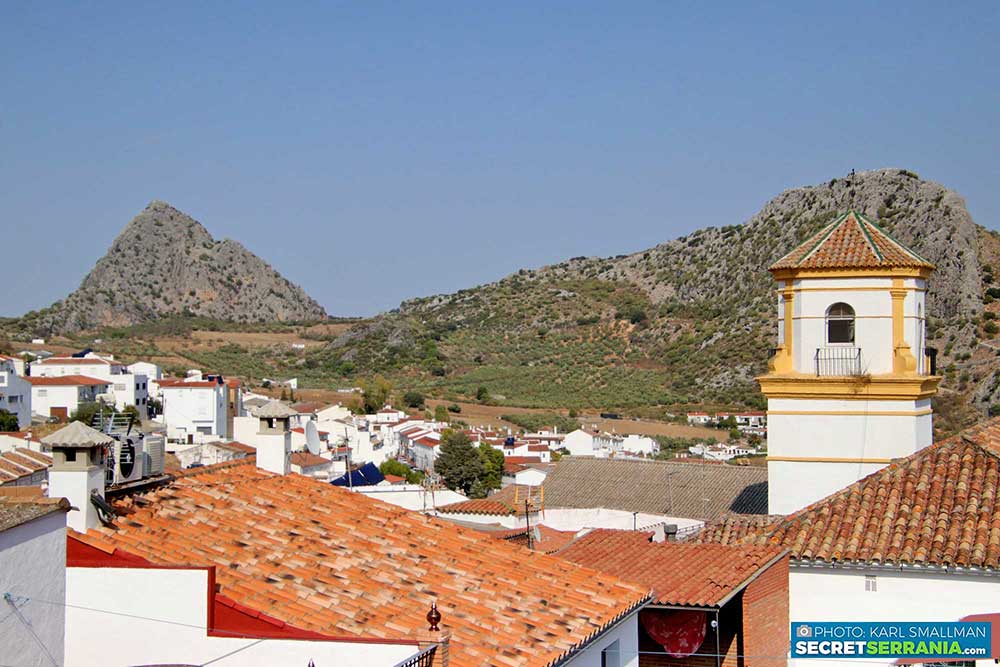 To be sure, I’m 73 now but the mind is still willing even if the flesh is weak. With the help of professionals, Casa Real is currently being re-configured and re-wired, prior to re-plastering, installing a new bathroom and extending the roof terrace. Then it will have a lick of paint prior to being offered as a vivienda rural to tourists who, since the Covid-19 lockdowns, are travelling again. To be sure, I’m 73 now but the mind is still willing even if the flesh is weak. With the help of professionals, Casa Real is currently being re-configured and re-wired, prior to re-plastering, installing a new bathroom and extending the roof terrace. Then it will have a lick of paint prior to being offered as a vivienda rural to tourists who, since the Covid-19 lockdowns, are travelling again.
This winter I am targeting the growing market for digital nomads. I’ve created two fully equipped workspaces for people who fancy working remotely. It’s a burgeoning trend. The Spanish government has even created a special visa and offered tax breaks to encourage more of these remote workers to choose Spain.
At my age maybe I should just hang up my DIY boots! But then this happened …..
A Victorian Pile in Hastings
In 2021, my son Tom and his wife Su, both actors, decided they needed a better quality of life before they started a family. So, they moved from London to the Sussex coast, to Hastings, where Su is from.
So, in early 2022 I spent a week in Hastings helping Tom with the renovation of a large, neglected Victorian terraced house which the couple had bought. By this time they had a son, Wilbur.
In the house, the main job was to replumb the place and strip out the century-old lead pipework, but we also did a lot of drylining of walls ready for plastering and I made a garden gate out of a recycled pallet.
Then Tom and Su had their second child, Buckley, a brother for Wilbur, so the building work needed to be put on hold.
I’m currently waiting for the call to go and help with painting and decorating and the installation of a new bathroom.
Watch this space!
© The Crazy Guy
Further reading:
The Building History of a 72-year-old DIY Fan (eyeonspain.com)
CASA MONTEJAQUE (a1-holidays.net)
Casa Rita Holiday Rental Montejaque - Secret Serrania de Ronda
DIGITAL NOMADS - Help me, Ronda (help-me-ronda.com)
Photographs:
Karl Smallman, www.secretserrania.com
Paul Whitelock, www.help-me-ronda.com
Note: This article is an adaptation and an updating of an original article written in 2000.
Tags: Casa Blanca, Casa Montejaque, Casa Real, Casa Rita, Crazy Guy, digital nomads, DIY, El Loco, Hastings, Latchford, Luxembourg, Piso Blanco Rincon, Ronda, Thelwall, Tunstall Villa, Victorian pile, Villa Indiana, Walkden, Warrington
 1
Like
Published at 9:37 AM Comments (0)
1
Like
Published at 9:37 AM Comments (0)
Spam post or Abuse? Please let us know
|
|